Types of Construction Projects
VerifiedAdded on 2021/06/01
|20
|6521
|356
AI Summary
Contribute Materials
Your contribution can guide someone’s learning journey. Share your
documents today.
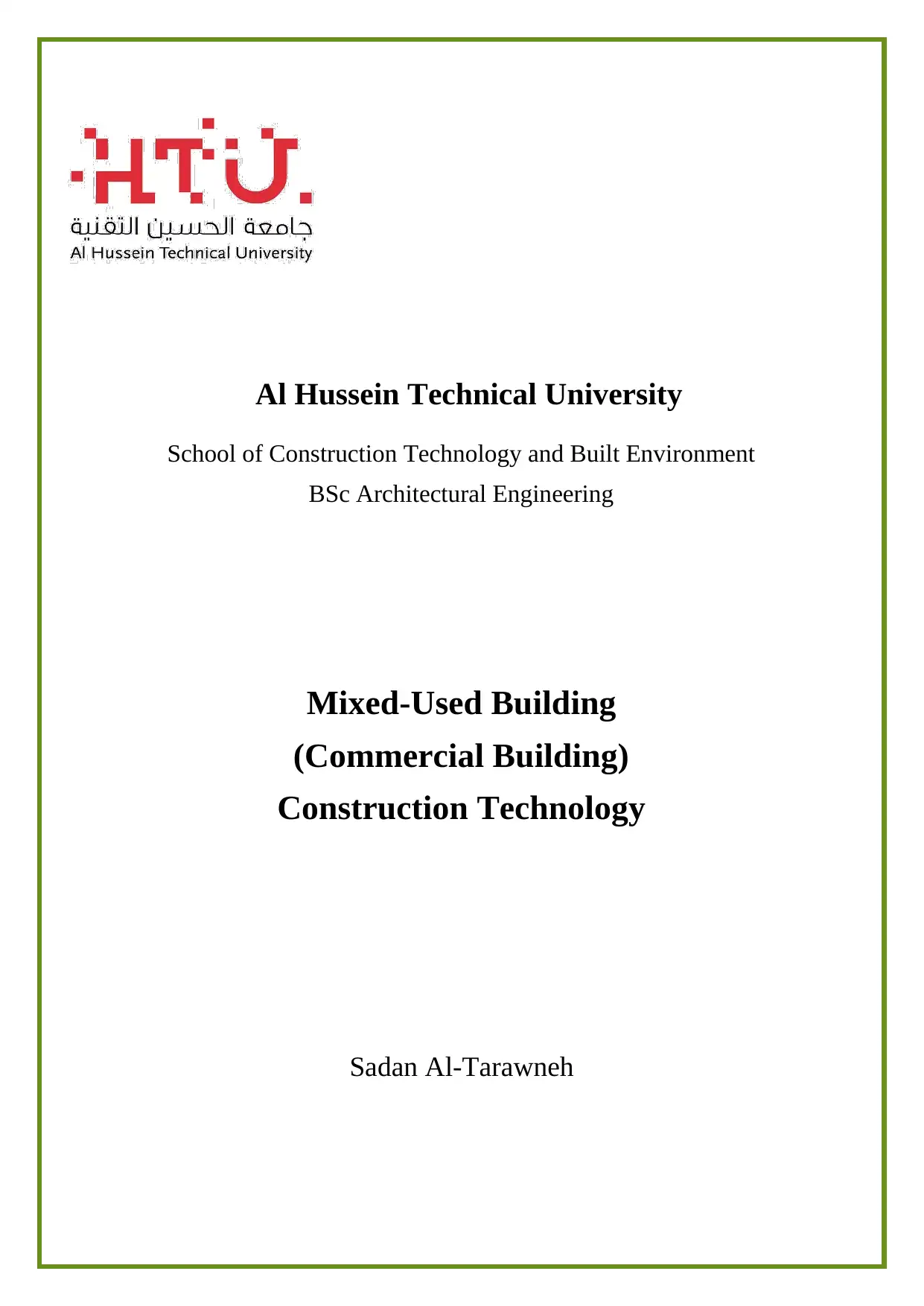
Al Hussein Technical University
School of Construction Technology and Built Environment
BSc Architectural Engineering
Mixed-Used Building
(Commercial Building)
Construction Technology
Sadan Al-Tarawneh
School of Construction Technology and Built Environment
BSc Architectural Engineering
Mixed-Used Building
(Commercial Building)
Construction Technology
Sadan Al-Tarawneh
Secure Best Marks with AI Grader
Need help grading? Try our AI Grader for instant feedback on your assignments.
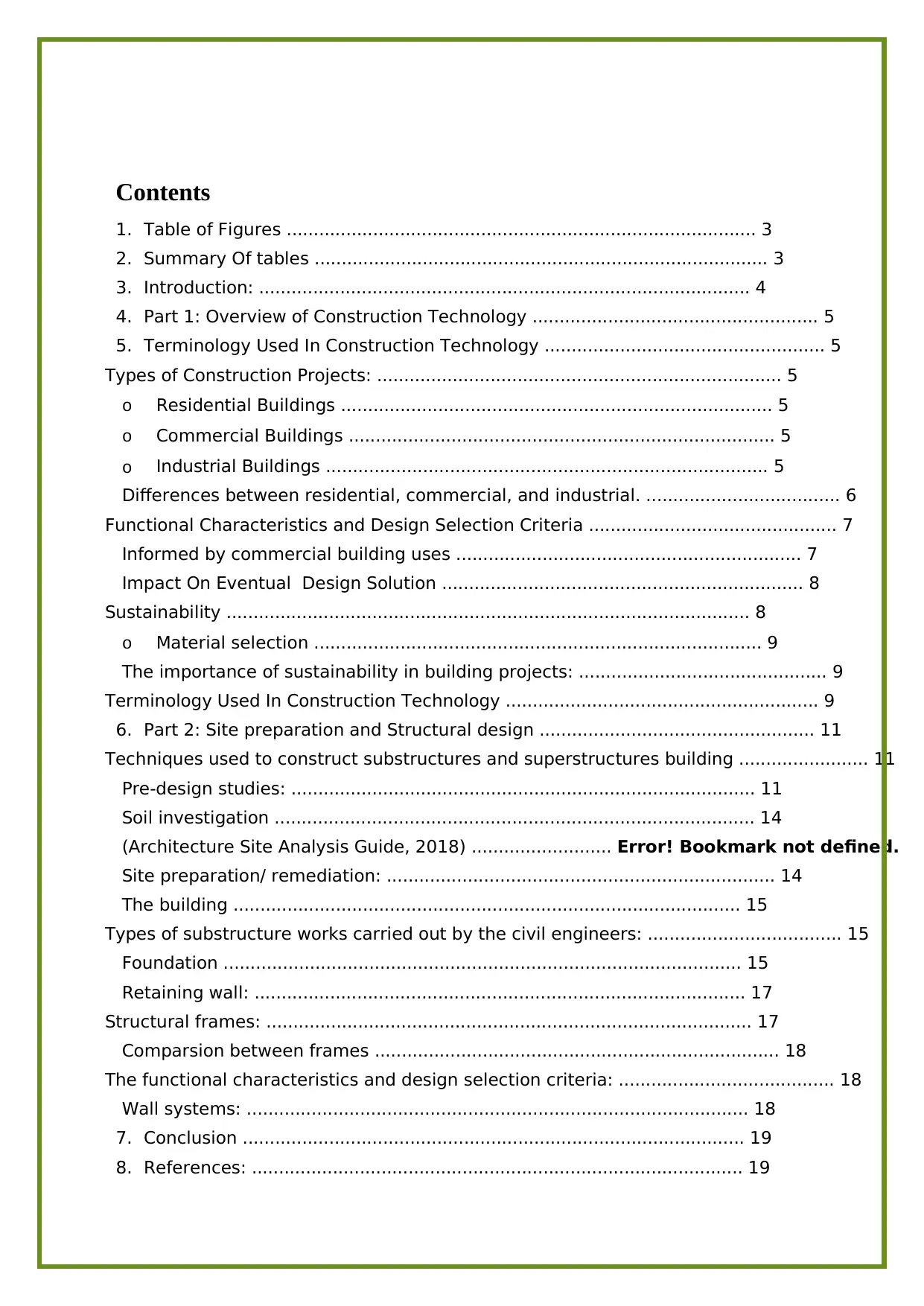
Contents
1. Table of Figures ....................................................................................... 3
2. Summary Of tables .................................................................................... 3
3. Introduction: ........................................................................................... 4
4. Part 1: Overview of Construction Technology ..................................................... 5
5. Terminology Used In Construction Technology .................................................... 5
Types of Construction Projects: ........................................................................... 5
o Residential Buildings ................................................................................ 5
o Commercial Buildings ............................................................................... 5
o Industrial Buildings .................................................................................. 5
Differences between residential, commercial, and industrial. .................................... 6
Functional Characteristics and Design Selection Criteria .............................................. 7
Informed by commercial building uses ................................................................ 7
Impact On Eventual Design Solution ................................................................... 8
Sustainability ................................................................................................. 8
o Material selection ................................................................................... 9
The importance of sustainability in building projects: .............................................. 9
Terminology Used In Construction Technology .......................................................... 9
6. Part 2: Site preparation and Structural design ................................................... 11
Techniques used to construct substructures and superstructures building ........................ 11
Pre-design studies: ...................................................................................... 11
Soil investigation ......................................................................................... 14
(Architecture Site Analysis Guide, 2018) .......................... Error! Bookmark not defined.
Site preparation/ remediation: ........................................................................ 14
The building .............................................................................................. 15
Types of substructure works carried out by the civil engineers: .................................... 15
Foundation ................................................................................................ 15
Retaining wall: ........................................................................................... 17
Structural frames: .......................................................................................... 17
Comparsion between frames ........................................................................... 18
The functional characteristics and design selection criteria: ........................................ 18
Wall systems: ............................................................................................. 18
7. Conclusion ............................................................................................. 19
8. References: ........................................................................................... 19
1. Table of Figures ....................................................................................... 3
2. Summary Of tables .................................................................................... 3
3. Introduction: ........................................................................................... 4
4. Part 1: Overview of Construction Technology ..................................................... 5
5. Terminology Used In Construction Technology .................................................... 5
Types of Construction Projects: ........................................................................... 5
o Residential Buildings ................................................................................ 5
o Commercial Buildings ............................................................................... 5
o Industrial Buildings .................................................................................. 5
Differences between residential, commercial, and industrial. .................................... 6
Functional Characteristics and Design Selection Criteria .............................................. 7
Informed by commercial building uses ................................................................ 7
Impact On Eventual Design Solution ................................................................... 8
Sustainability ................................................................................................. 8
o Material selection ................................................................................... 9
The importance of sustainability in building projects: .............................................. 9
Terminology Used In Construction Technology .......................................................... 9
6. Part 2: Site preparation and Structural design ................................................... 11
Techniques used to construct substructures and superstructures building ........................ 11
Pre-design studies: ...................................................................................... 11
Soil investigation ......................................................................................... 14
(Architecture Site Analysis Guide, 2018) .......................... Error! Bookmark not defined.
Site preparation/ remediation: ........................................................................ 14
The building .............................................................................................. 15
Types of substructure works carried out by the civil engineers: .................................... 15
Foundation ................................................................................................ 15
Retaining wall: ........................................................................................... 17
Structural frames: .......................................................................................... 17
Comparsion between frames ........................................................................... 18
The functional characteristics and design selection criteria: ........................................ 18
Wall systems: ............................................................................................. 18
7. Conclusion ............................................................................................. 19
8. References: ........................................................................................... 19
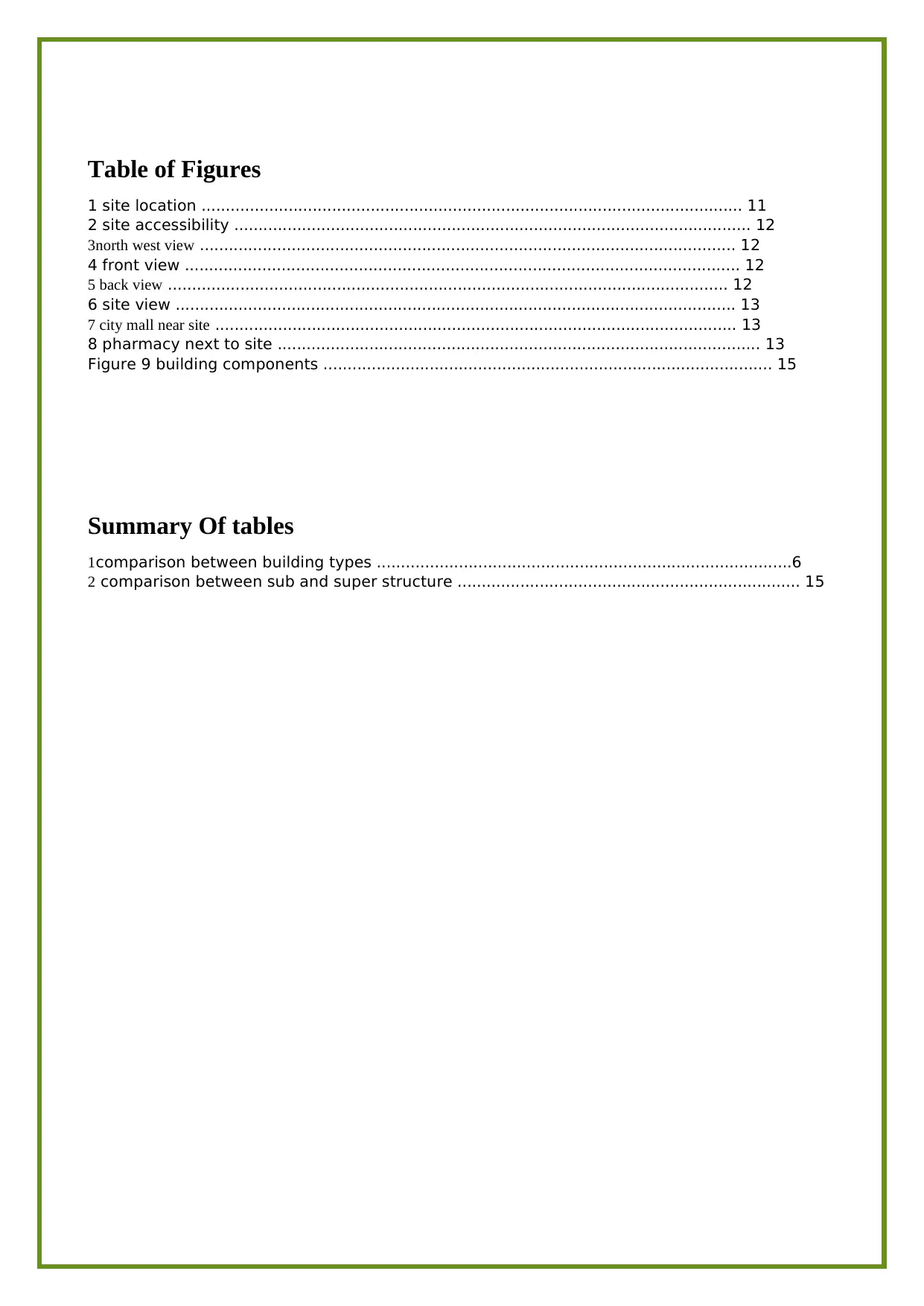
Table of Figures
1 site location ................................................................................................................ 11
2 site accessibility ........................................................................................................... 12
3north west view ............................................................................................................... 12
4 front view ................................................................................................................... 12
5 back view .................................................................................................................... 12
6 site view .................................................................................................................... 13
7 city mall near site ............................................................................................................ 13
8 pharmacy next to site .................................................................................................... 13
Figure 9 building components ............................................................................................. 15
Summary Of tables
1comparison between building types ......................................................................................6
2 comparison between sub and super structure ....................................................................... 15
1 site location ................................................................................................................ 11
2 site accessibility ........................................................................................................... 12
3north west view ............................................................................................................... 12
4 front view ................................................................................................................... 12
5 back view .................................................................................................................... 12
6 site view .................................................................................................................... 13
7 city mall near site ............................................................................................................ 13
8 pharmacy next to site .................................................................................................... 13
Figure 9 building components ............................................................................................. 15
Summary Of tables
1comparison between building types ......................................................................................6
2 comparison between sub and super structure ....................................................................... 15
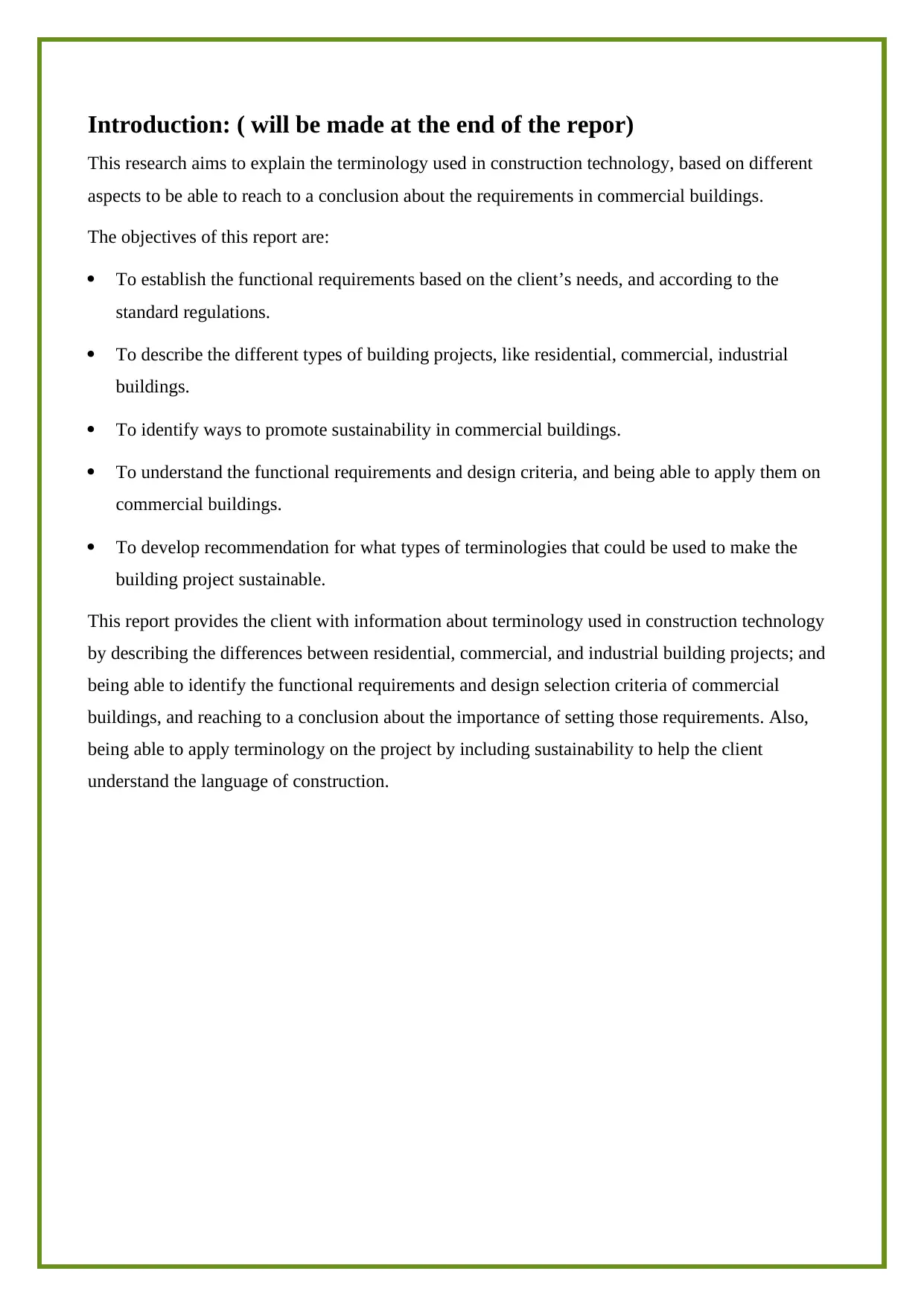
Introduction: ( will be made at the end of the repor)
This research aims to explain the terminology used in construction technology, based on different
aspects to be able to reach to a conclusion about the requirements in commercial buildings.
The objectives of this report are:
To establish the functional requirements based on the client’s needs, and according to the
standard regulations.
To describe the different types of building projects, like residential, commercial, industrial
buildings.
To identify ways to promote sustainability in commercial buildings.
To understand the functional requirements and design criteria, and being able to apply them on
commercial buildings.
To develop recommendation for what types of terminologies that could be used to make the
building project sustainable.
This report provides the client with information about terminology used in construction technology
by describing the differences between residential, commercial, and industrial building projects; and
being able to identify the functional requirements and design selection criteria of commercial
buildings, and reaching to a conclusion about the importance of setting those requirements. Also,
being able to apply terminology on the project by including sustainability to help the client
understand the language of construction.
This research aims to explain the terminology used in construction technology, based on different
aspects to be able to reach to a conclusion about the requirements in commercial buildings.
The objectives of this report are:
To establish the functional requirements based on the client’s needs, and according to the
standard regulations.
To describe the different types of building projects, like residential, commercial, industrial
buildings.
To identify ways to promote sustainability in commercial buildings.
To understand the functional requirements and design criteria, and being able to apply them on
commercial buildings.
To develop recommendation for what types of terminologies that could be used to make the
building project sustainable.
This report provides the client with information about terminology used in construction technology
by describing the differences between residential, commercial, and industrial building projects; and
being able to identify the functional requirements and design selection criteria of commercial
buildings, and reaching to a conclusion about the importance of setting those requirements. Also,
being able to apply terminology on the project by including sustainability to help the client
understand the language of construction.
Secure Best Marks with AI Grader
Need help grading? Try our AI Grader for instant feedback on your assignments.
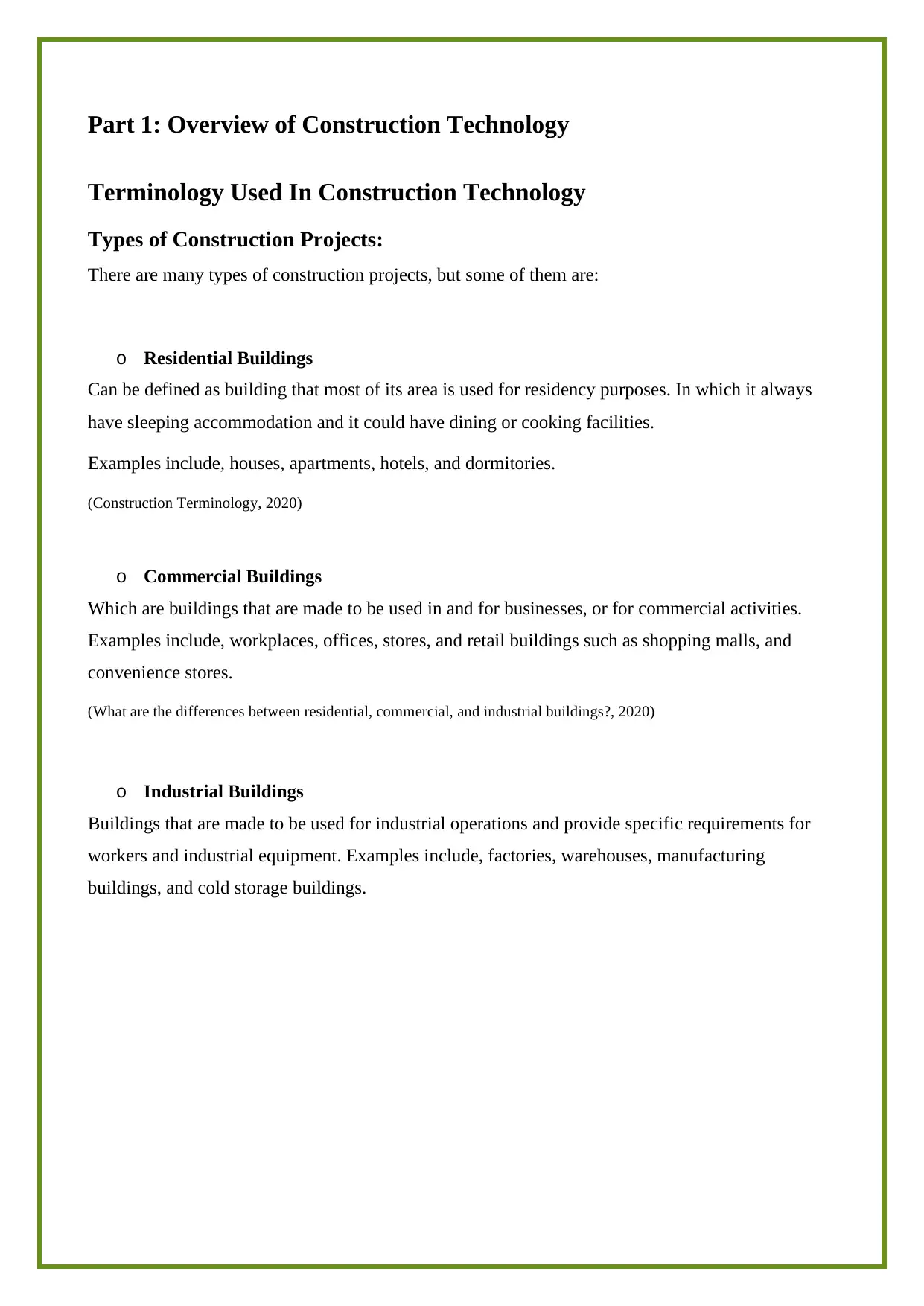
Part 1: Overview of Construction Technology
Terminology Used In Construction Technology
Types of Construction Projects:
There are many types of construction projects, but some of them are:
o Residential Buildings
Can be defined as building that most of its area is used for residency purposes. In which it always
have sleeping accommodation and it could have dining or cooking facilities.
Examples include, houses, apartments, hotels, and dormitories.
(Construction Terminology, 2020)
o Commercial Buildings
Which are buildings that are made to be used in and for businesses, or for commercial activities.
Examples include, workplaces, offices, stores, and retail buildings such as shopping malls, and
convenience stores.
(What are the differences between residential, commercial, and industrial buildings?, 2020)
o Industrial Buildings
Buildings that are made to be used for industrial operations and provide specific requirements for
workers and industrial equipment. Examples include, factories, warehouses, manufacturing
buildings, and cold storage buildings.
Terminology Used In Construction Technology
Types of Construction Projects:
There are many types of construction projects, but some of them are:
o Residential Buildings
Can be defined as building that most of its area is used for residency purposes. In which it always
have sleeping accommodation and it could have dining or cooking facilities.
Examples include, houses, apartments, hotels, and dormitories.
(Construction Terminology, 2020)
o Commercial Buildings
Which are buildings that are made to be used in and for businesses, or for commercial activities.
Examples include, workplaces, offices, stores, and retail buildings such as shopping malls, and
convenience stores.
(What are the differences between residential, commercial, and industrial buildings?, 2020)
o Industrial Buildings
Buildings that are made to be used for industrial operations and provide specific requirements for
workers and industrial equipment. Examples include, factories, warehouses, manufacturing
buildings, and cold storage buildings.
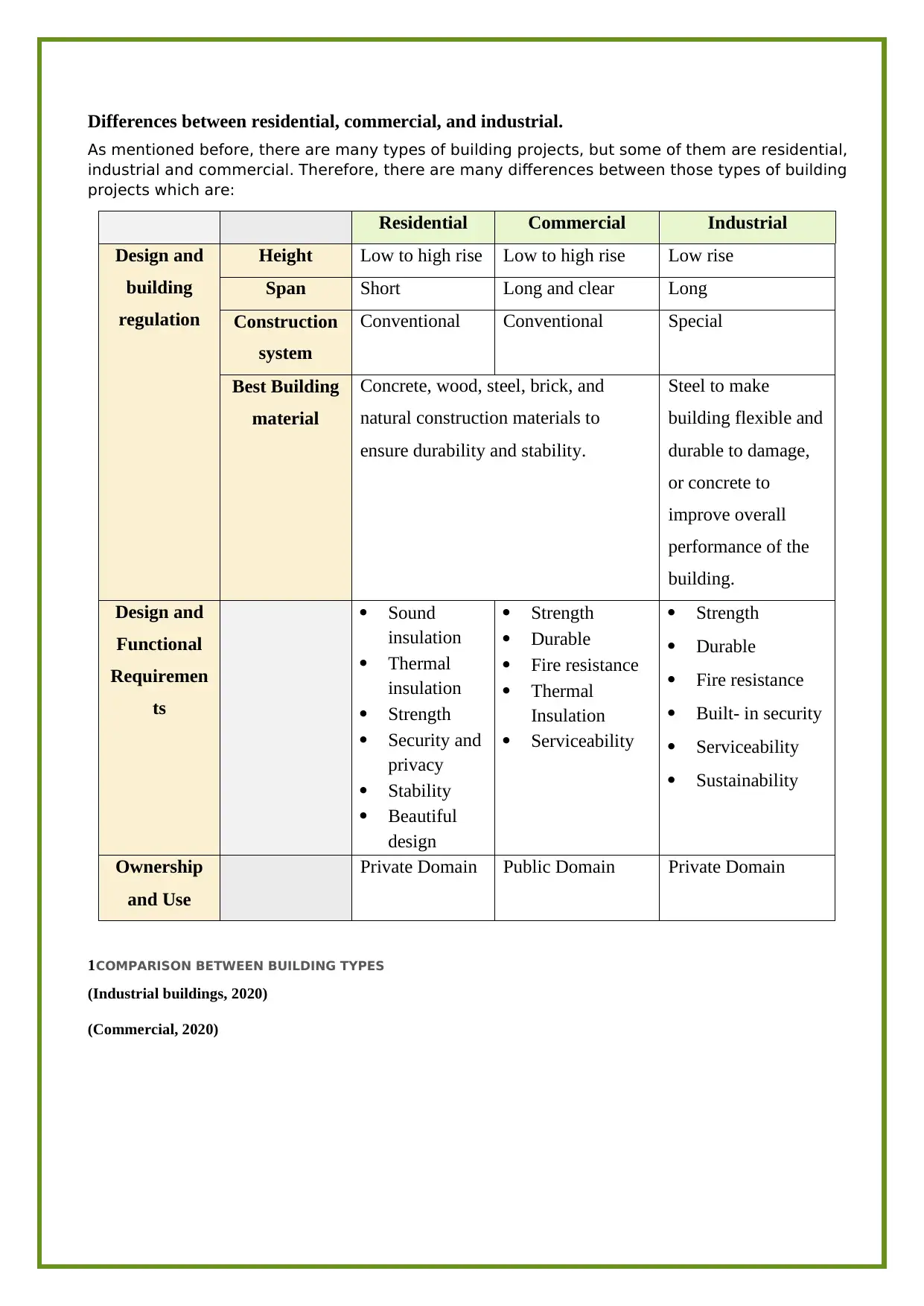
Differences between residential, commercial, and industrial.
As mentioned before, there are many types of building projects, but some of them are residential,
industrial and commercial. Therefore, there are many differences between those types of building
projects which are:
Residential Commercial Industrial
Design and
building
regulation
Height Low to high rise Low to high rise Low rise
Span Short Long and clear Long
Construction
system
Conventional Conventional Special
Best Building
material
Concrete, wood, steel, brick, and
natural construction materials to
ensure durability and stability.
Steel to make
building flexible and
durable to damage,
or concrete to
improve overall
performance of the
building.
Design and
Functional
Requiremen
ts
Sound
insulation
Thermal
insulation
Strength
Security and
privacy
Stability
Beautiful
design
Strength
Durable
Fire resistance
Thermal
Insulation
Serviceability
Strength
Durable
Fire resistance
Built- in security
Serviceability
Sustainability
Ownership
and Use
Private Domain Public Domain Private Domain
1COMPARISON BETWEEN BUILDING TYPES
(Industrial buildings, 2020)
(Commercial, 2020)
As mentioned before, there are many types of building projects, but some of them are residential,
industrial and commercial. Therefore, there are many differences between those types of building
projects which are:
Residential Commercial Industrial
Design and
building
regulation
Height Low to high rise Low to high rise Low rise
Span Short Long and clear Long
Construction
system
Conventional Conventional Special
Best Building
material
Concrete, wood, steel, brick, and
natural construction materials to
ensure durability and stability.
Steel to make
building flexible and
durable to damage,
or concrete to
improve overall
performance of the
building.
Design and
Functional
Requiremen
ts
Sound
insulation
Thermal
insulation
Strength
Security and
privacy
Stability
Beautiful
design
Strength
Durable
Fire resistance
Thermal
Insulation
Serviceability
Strength
Durable
Fire resistance
Built- in security
Serviceability
Sustainability
Ownership
and Use
Private Domain Public Domain Private Domain
1COMPARISON BETWEEN BUILDING TYPES
(Industrial buildings, 2020)
(Commercial, 2020)
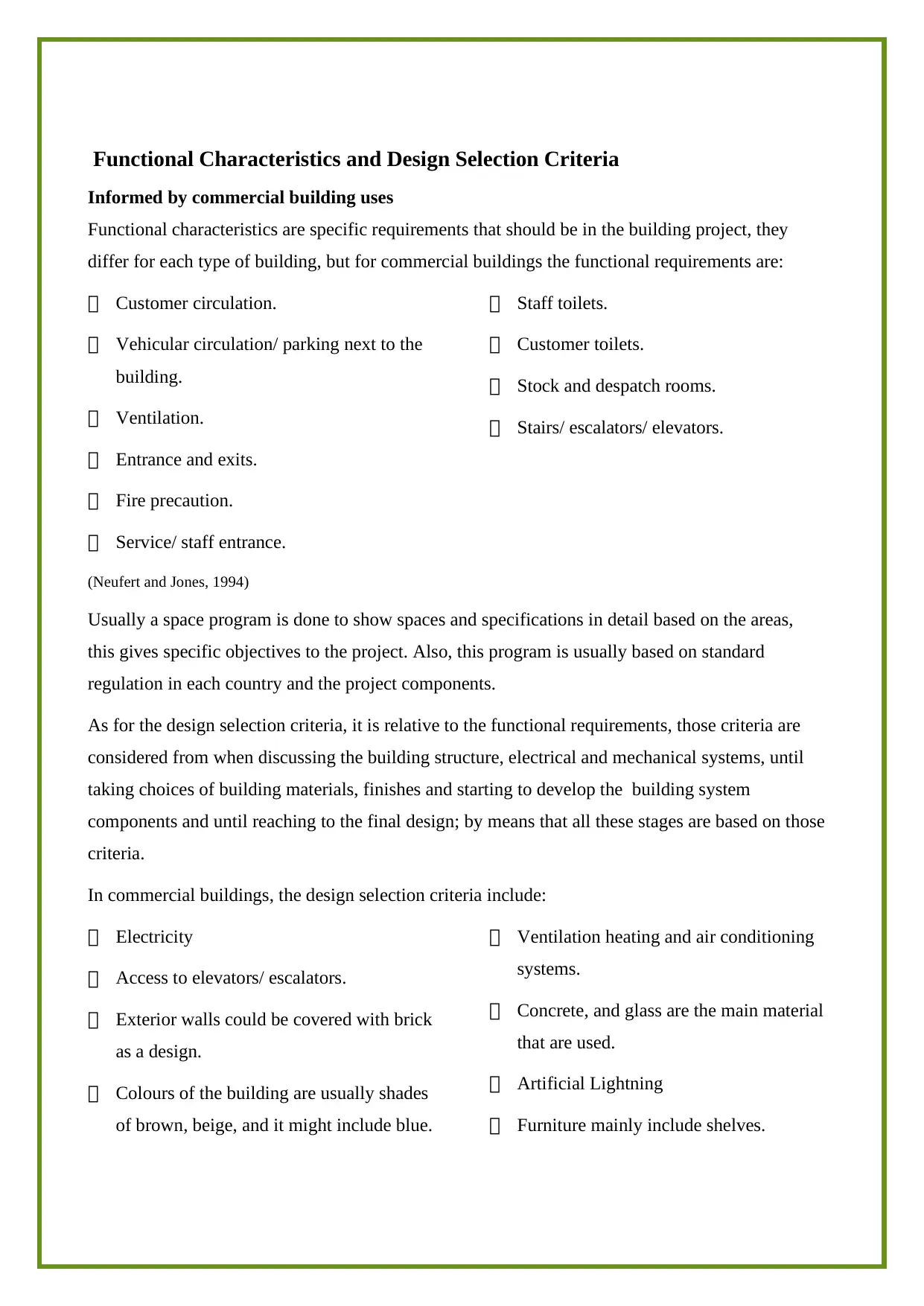
Functional Characteristics and Design Selection Criteria
Informed by commercial building uses
Functional characteristics are specific requirements that should be in the building project, they
differ for each type of building, but for commercial buildings the functional requirements are:
Customer circulation.
Vehicular circulation/ parking next to the
building.
Ventilation.
Entrance and exits.
Fire precaution.
Service/ staff entrance.
Staff toilets.
Customer toilets.
Stock and despatch rooms.
Stairs/ escalators/ elevators.
(Neufert and Jones, 1994)
Usually a space program is done to show spaces and specifications in detail based on the areas,
this gives specific objectives to the project. Also, this program is usually based on standard
regulation in each country and the project components.
As for the design selection criteria, it is relative to the functional requirements, those criteria are
considered from when discussing the building structure, electrical and mechanical systems, until
taking choices of building materials, finishes and starting to develop the building system
components and until reaching to the final design; by means that all these stages are based on those
criteria.
In commercial buildings, the design selection criteria include:
Electricity
Access to elevators/ escalators.
Exterior walls could be covered with brick
as a design.
Colours of the building are usually shades
of brown, beige, and it might include blue.
Ventilation heating and air conditioning
systems.
Concrete, and glass are the main material
that are used.
Artificial Lightning
Furniture mainly include shelves.
Informed by commercial building uses
Functional characteristics are specific requirements that should be in the building project, they
differ for each type of building, but for commercial buildings the functional requirements are:
Customer circulation.
Vehicular circulation/ parking next to the
building.
Ventilation.
Entrance and exits.
Fire precaution.
Service/ staff entrance.
Staff toilets.
Customer toilets.
Stock and despatch rooms.
Stairs/ escalators/ elevators.
(Neufert and Jones, 1994)
Usually a space program is done to show spaces and specifications in detail based on the areas,
this gives specific objectives to the project. Also, this program is usually based on standard
regulation in each country and the project components.
As for the design selection criteria, it is relative to the functional requirements, those criteria are
considered from when discussing the building structure, electrical and mechanical systems, until
taking choices of building materials, finishes and starting to develop the building system
components and until reaching to the final design; by means that all these stages are based on those
criteria.
In commercial buildings, the design selection criteria include:
Electricity
Access to elevators/ escalators.
Exterior walls could be covered with brick
as a design.
Colours of the building are usually shades
of brown, beige, and it might include blue.
Ventilation heating and air conditioning
systems.
Concrete, and glass are the main material
that are used.
Artificial Lightning
Furniture mainly include shelves.
Paraphrase This Document
Need a fresh take? Get an instant paraphrase of this document with our AI Paraphraser
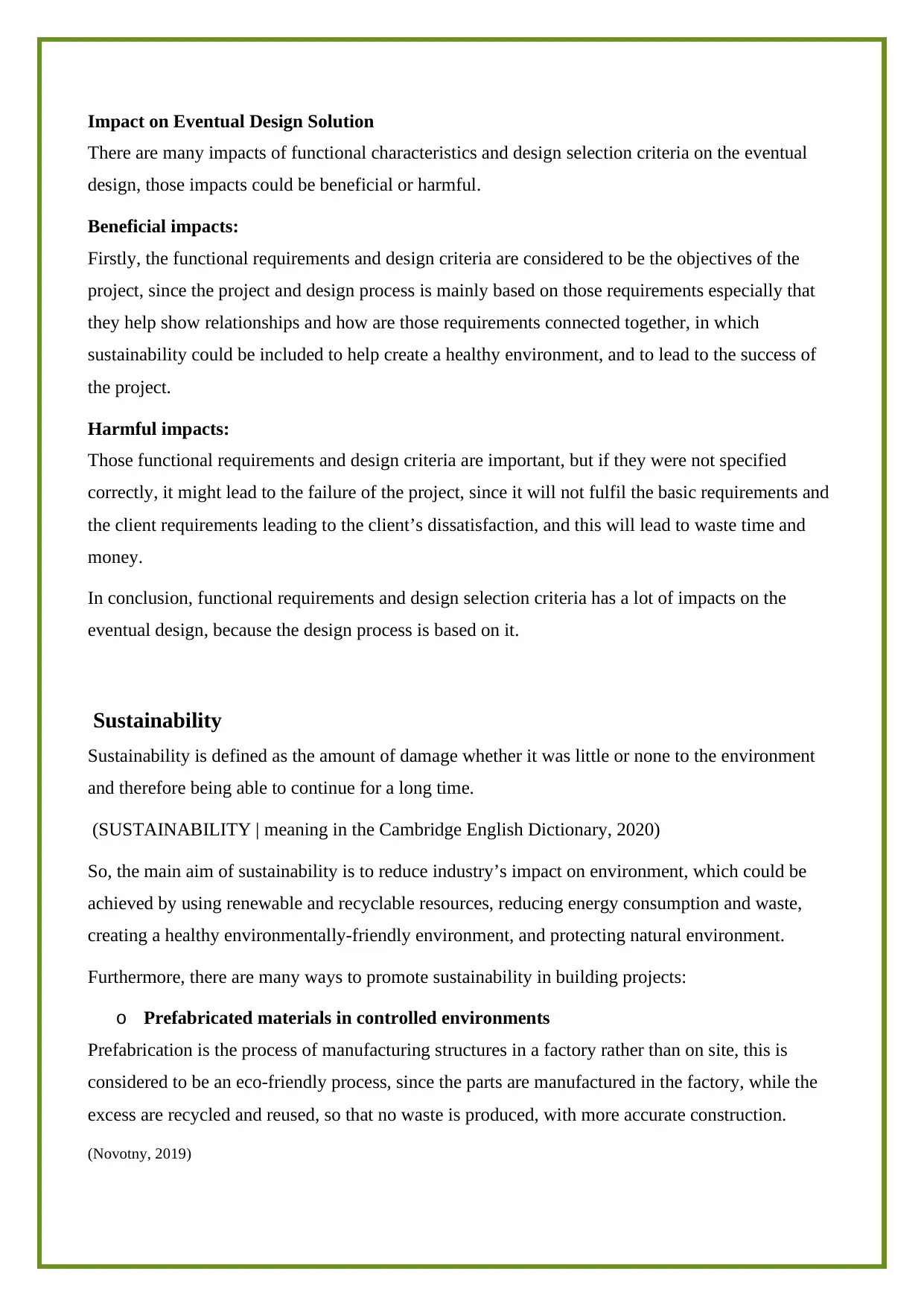
Impact on Eventual Design Solution
There are many impacts of functional characteristics and design selection criteria on the eventual
design, those impacts could be beneficial or harmful.
Beneficial impacts:
Firstly, the functional requirements and design criteria are considered to be the objectives of the
project, since the project and design process is mainly based on those requirements especially that
they help show relationships and how are those requirements connected together, in which
sustainability could be included to help create a healthy environment, and to lead to the success of
the project.
Harmful impacts:
Those functional requirements and design criteria are important, but if they were not specified
correctly, it might lead to the failure of the project, since it will not fulfil the basic requirements and
the client requirements leading to the client’s dissatisfaction, and this will lead to waste time and
money.
In conclusion, functional requirements and design selection criteria has a lot of impacts on the
eventual design, because the design process is based on it.
Sustainability
Sustainability is defined as the amount of damage whether it was little or none to the environment
and therefore being able to continue for a long time.
(SUSTAINABILITY | meaning in the Cambridge English Dictionary, 2020)
So, the main aim of sustainability is to reduce industry’s impact on environment, which could be
achieved by using renewable and recyclable resources, reducing energy consumption and waste,
creating a healthy environmentally-friendly environment, and protecting natural environment.
Furthermore, there are many ways to promote sustainability in building projects:
o Prefabricated materials in controlled environments
Prefabrication is the process of manufacturing structures in a factory rather than on site, this is
considered to be an eco-friendly process, since the parts are manufactured in the factory, while the
excess are recycled and reused, so that no waste is produced, with more accurate construction.
(Novotny, 2019)
There are many impacts of functional characteristics and design selection criteria on the eventual
design, those impacts could be beneficial or harmful.
Beneficial impacts:
Firstly, the functional requirements and design criteria are considered to be the objectives of the
project, since the project and design process is mainly based on those requirements especially that
they help show relationships and how are those requirements connected together, in which
sustainability could be included to help create a healthy environment, and to lead to the success of
the project.
Harmful impacts:
Those functional requirements and design criteria are important, but if they were not specified
correctly, it might lead to the failure of the project, since it will not fulfil the basic requirements and
the client requirements leading to the client’s dissatisfaction, and this will lead to waste time and
money.
In conclusion, functional requirements and design selection criteria has a lot of impacts on the
eventual design, because the design process is based on it.
Sustainability
Sustainability is defined as the amount of damage whether it was little or none to the environment
and therefore being able to continue for a long time.
(SUSTAINABILITY | meaning in the Cambridge English Dictionary, 2020)
So, the main aim of sustainability is to reduce industry’s impact on environment, which could be
achieved by using renewable and recyclable resources, reducing energy consumption and waste,
creating a healthy environmentally-friendly environment, and protecting natural environment.
Furthermore, there are many ways to promote sustainability in building projects:
o Prefabricated materials in controlled environments
Prefabrication is the process of manufacturing structures in a factory rather than on site, this is
considered to be an eco-friendly process, since the parts are manufactured in the factory, while the
excess are recycled and reused, so that no waste is produced, with more accurate construction.
(Novotny, 2019)
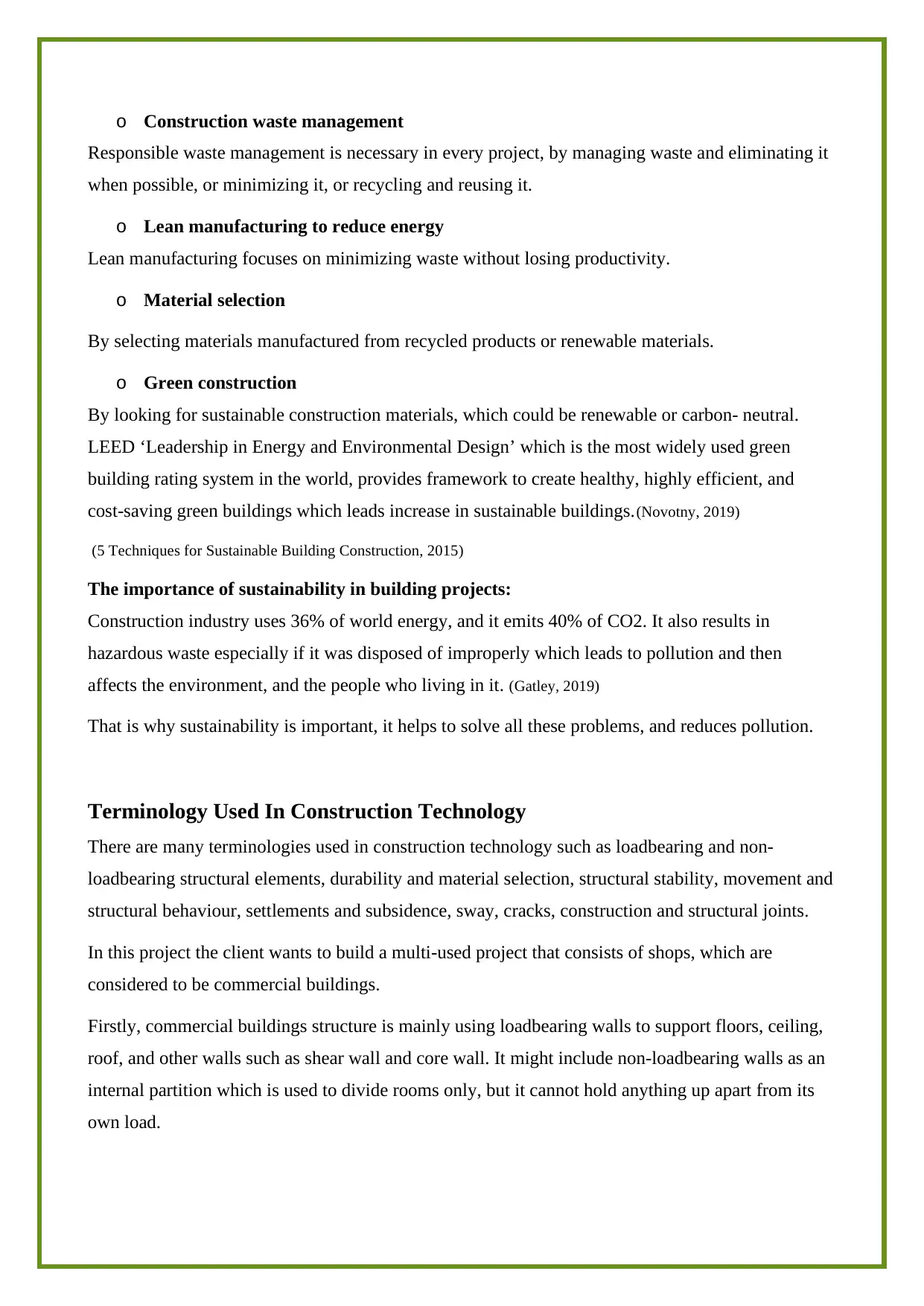
o Construction waste management
Responsible waste management is necessary in every project, by managing waste and eliminating it
when possible, or minimizing it, or recycling and reusing it.
o Lean manufacturing to reduce energy
Lean manufacturing focuses on minimizing waste without losing productivity.
o Material selection
By selecting materials manufactured from recycled products or renewable materials.
o Green construction
By looking for sustainable construction materials, which could be renewable or carbon- neutral.
LEED ‘Leadership in Energy and Environmental Design’ which is the most widely used green
building rating system in the world, provides framework to create healthy, highly efficient, and
cost-saving green buildings which leads increase in sustainable buildings.(Novotny, 2019)
(5 Techniques for Sustainable Building Construction, 2015)
The importance of sustainability in building projects:
Construction industry uses 36% of world energy, and it emits 40% of CO2. It also results in
hazardous waste especially if it was disposed of improperly which leads to pollution and then
affects the environment, and the people who living in it. (Gatley, 2019)
That is why sustainability is important, it helps to solve all these problems, and reduces pollution.
Terminology Used In Construction Technology
There are many terminologies used in construction technology such as loadbearing and non-
loadbearing structural elements, durability and material selection, structural stability, movement and
structural behaviour, settlements and subsidence, sway, cracks, construction and structural joints.
In this project the client wants to build a multi-used project that consists of shops, which are
considered to be commercial buildings.
Firstly, commercial buildings structure is mainly using loadbearing walls to support floors, ceiling,
roof, and other walls such as shear wall and core wall. It might include non-loadbearing walls as an
internal partition which is used to divide rooms only, but it cannot hold anything up apart from its
own load.
Responsible waste management is necessary in every project, by managing waste and eliminating it
when possible, or minimizing it, or recycling and reusing it.
o Lean manufacturing to reduce energy
Lean manufacturing focuses on minimizing waste without losing productivity.
o Material selection
By selecting materials manufactured from recycled products or renewable materials.
o Green construction
By looking for sustainable construction materials, which could be renewable or carbon- neutral.
LEED ‘Leadership in Energy and Environmental Design’ which is the most widely used green
building rating system in the world, provides framework to create healthy, highly efficient, and
cost-saving green buildings which leads increase in sustainable buildings.(Novotny, 2019)
(5 Techniques for Sustainable Building Construction, 2015)
The importance of sustainability in building projects:
Construction industry uses 36% of world energy, and it emits 40% of CO2. It also results in
hazardous waste especially if it was disposed of improperly which leads to pollution and then
affects the environment, and the people who living in it. (Gatley, 2019)
That is why sustainability is important, it helps to solve all these problems, and reduces pollution.
Terminology Used In Construction Technology
There are many terminologies used in construction technology such as loadbearing and non-
loadbearing structural elements, durability and material selection, structural stability, movement and
structural behaviour, settlements and subsidence, sway, cracks, construction and structural joints.
In this project the client wants to build a multi-used project that consists of shops, which are
considered to be commercial buildings.
Firstly, commercial buildings structure is mainly using loadbearing walls to support floors, ceiling,
roof, and other walls such as shear wall and core wall. It might include non-loadbearing walls as an
internal partition which is used to divide rooms only, but it cannot hold anything up apart from its
own load.
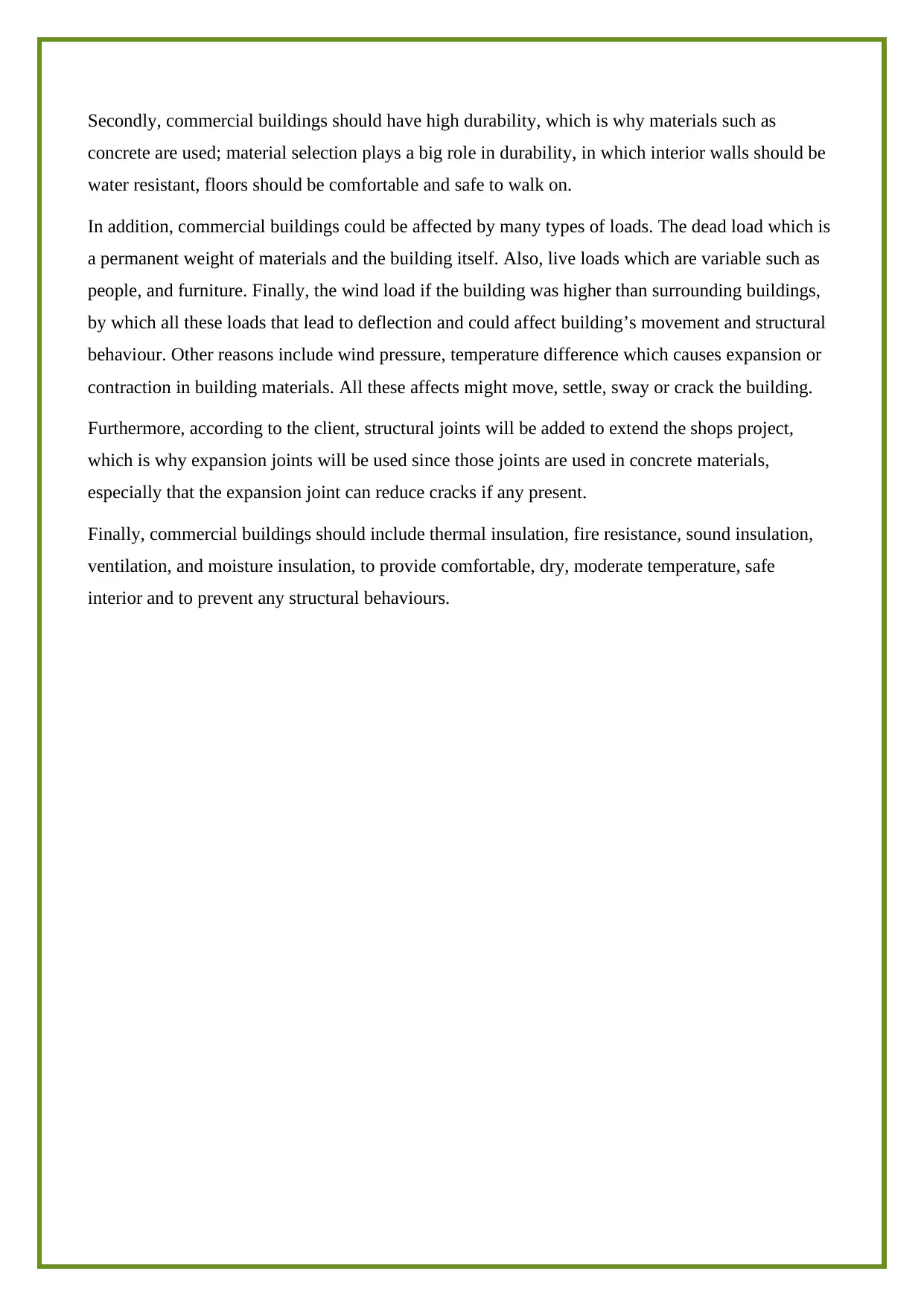
Secondly, commercial buildings should have high durability, which is why materials such as
concrete are used; material selection plays a big role in durability, in which interior walls should be
water resistant, floors should be comfortable and safe to walk on.
In addition, commercial buildings could be affected by many types of loads. The dead load which is
a permanent weight of materials and the building itself. Also, live loads which are variable such as
people, and furniture. Finally, the wind load if the building was higher than surrounding buildings,
by which all these loads that lead to deflection and could affect building’s movement and structural
behaviour. Other reasons include wind pressure, temperature difference which causes expansion or
contraction in building materials. All these affects might move, settle, sway or crack the building.
Furthermore, according to the client, structural joints will be added to extend the shops project,
which is why expansion joints will be used since those joints are used in concrete materials,
especially that the expansion joint can reduce cracks if any present.
Finally, commercial buildings should include thermal insulation, fire resistance, sound insulation,
ventilation, and moisture insulation, to provide comfortable, dry, moderate temperature, safe
interior and to prevent any structural behaviours.
concrete are used; material selection plays a big role in durability, in which interior walls should be
water resistant, floors should be comfortable and safe to walk on.
In addition, commercial buildings could be affected by many types of loads. The dead load which is
a permanent weight of materials and the building itself. Also, live loads which are variable such as
people, and furniture. Finally, the wind load if the building was higher than surrounding buildings,
by which all these loads that lead to deflection and could affect building’s movement and structural
behaviour. Other reasons include wind pressure, temperature difference which causes expansion or
contraction in building materials. All these affects might move, settle, sway or crack the building.
Furthermore, according to the client, structural joints will be added to extend the shops project,
which is why expansion joints will be used since those joints are used in concrete materials,
especially that the expansion joint can reduce cracks if any present.
Finally, commercial buildings should include thermal insulation, fire resistance, sound insulation,
ventilation, and moisture insulation, to provide comfortable, dry, moderate temperature, safe
interior and to prevent any structural behaviours.
Secure Best Marks with AI Grader
Need help grading? Try our AI Grader for instant feedback on your assignments.
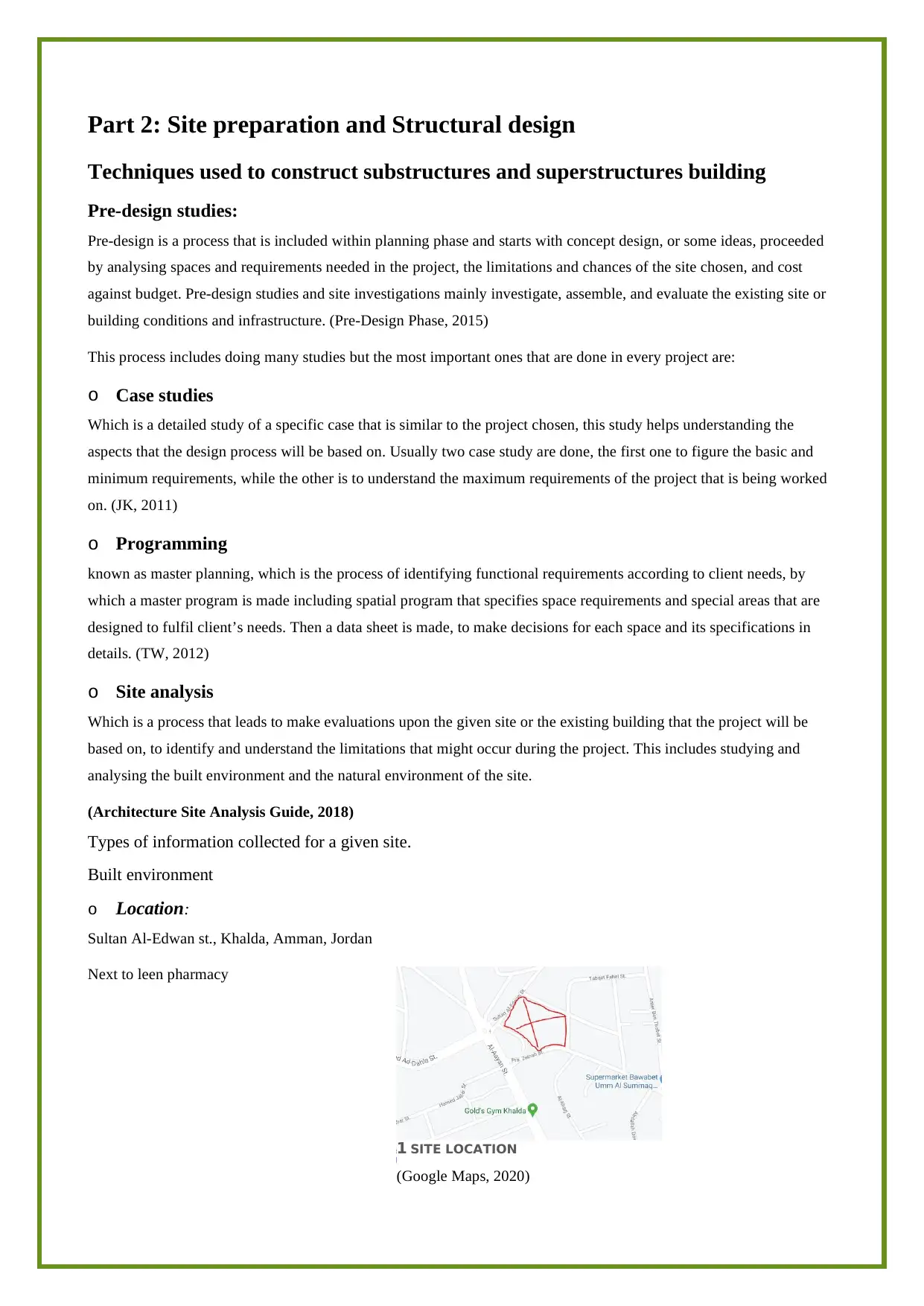
Part 2: Site preparation and Structural design
Techniques used to construct substructures and superstructures building
Pre-design studies:
Pre-design is a process that is included within planning phase and starts with concept design, or some ideas, proceeded
by analysing spaces and requirements needed in the project, the limitations and chances of the site chosen, and cost
against budget. Pre-design studies and site investigations mainly investigate, assemble, and evaluate the existing site or
building conditions and infrastructure. (Pre-Design Phase, 2015)
This process includes doing many studies but the most important ones that are done in every project are:
o Case studies
Which is a detailed study of a specific case that is similar to the project chosen, this study helps understanding the
aspects that the design process will be based on. Usually two case study are done, the first one to figure the basic and
minimum requirements, while the other is to understand the maximum requirements of the project that is being worked
on. (JK, 2011)
o Programming
known as master planning, which is the process of identifying functional requirements according to client needs, by
which a master program is made including spatial program that specifies space requirements and special areas that are
designed to fulfil client’s needs. Then a data sheet is made, to make decisions for each space and its specifications in
details. (TW, 2012)
o Site analysis
Which is a process that leads to make evaluations upon the given site or the existing building that the project will be
based on, to identify and understand the limitations that might occur during the project. This includes studying and
analysing the built environment and the natural environment of the site.
(Architecture Site Analysis Guide, 2018)
Types of information collected for a given site.
Built environment
o Location:
Sultan Al-Edwan st., Khalda, Amman, Jordan
Next to leen pharmacy
1 SITE LOCATION
(Google Maps, 2020)
Techniques used to construct substructures and superstructures building
Pre-design studies:
Pre-design is a process that is included within planning phase and starts with concept design, or some ideas, proceeded
by analysing spaces and requirements needed in the project, the limitations and chances of the site chosen, and cost
against budget. Pre-design studies and site investigations mainly investigate, assemble, and evaluate the existing site or
building conditions and infrastructure. (Pre-Design Phase, 2015)
This process includes doing many studies but the most important ones that are done in every project are:
o Case studies
Which is a detailed study of a specific case that is similar to the project chosen, this study helps understanding the
aspects that the design process will be based on. Usually two case study are done, the first one to figure the basic and
minimum requirements, while the other is to understand the maximum requirements of the project that is being worked
on. (JK, 2011)
o Programming
known as master planning, which is the process of identifying functional requirements according to client needs, by
which a master program is made including spatial program that specifies space requirements and special areas that are
designed to fulfil client’s needs. Then a data sheet is made, to make decisions for each space and its specifications in
details. (TW, 2012)
o Site analysis
Which is a process that leads to make evaluations upon the given site or the existing building that the project will be
based on, to identify and understand the limitations that might occur during the project. This includes studying and
analysing the built environment and the natural environment of the site.
(Architecture Site Analysis Guide, 2018)
Types of information collected for a given site.
Built environment
o Location:
Sultan Al-Edwan st., Khalda, Amman, Jordan
Next to leen pharmacy
1 SITE LOCATION
(Google Maps, 2020)
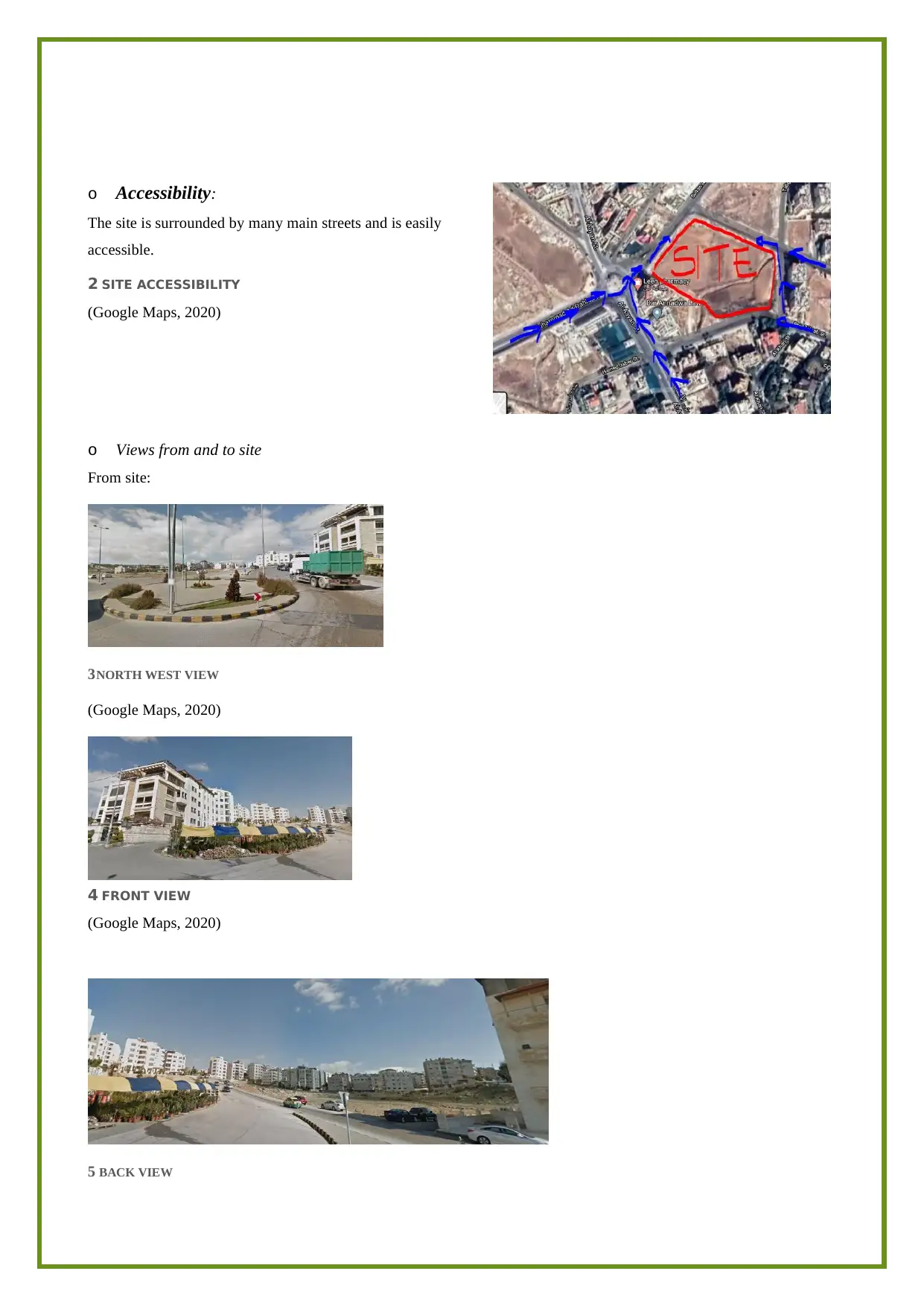
o Accessibility:
The site is surrounded by many main streets and is easily
accessible.
o Views from and to site
From site:
3NORTH WEST VIEW
(Google Maps, 2020)
5 BACK VIEW
4 FRONT VIEW
(Google Maps, 2020)
2 SITE ACCESSIBILITY
(Google Maps, 2020)
The site is surrounded by many main streets and is easily
accessible.
o Views from and to site
From site:
3NORTH WEST VIEW
(Google Maps, 2020)
5 BACK VIEW
4 FRONT VIEW
(Google Maps, 2020)
2 SITE ACCESSIBILITY
(Google Maps, 2020)
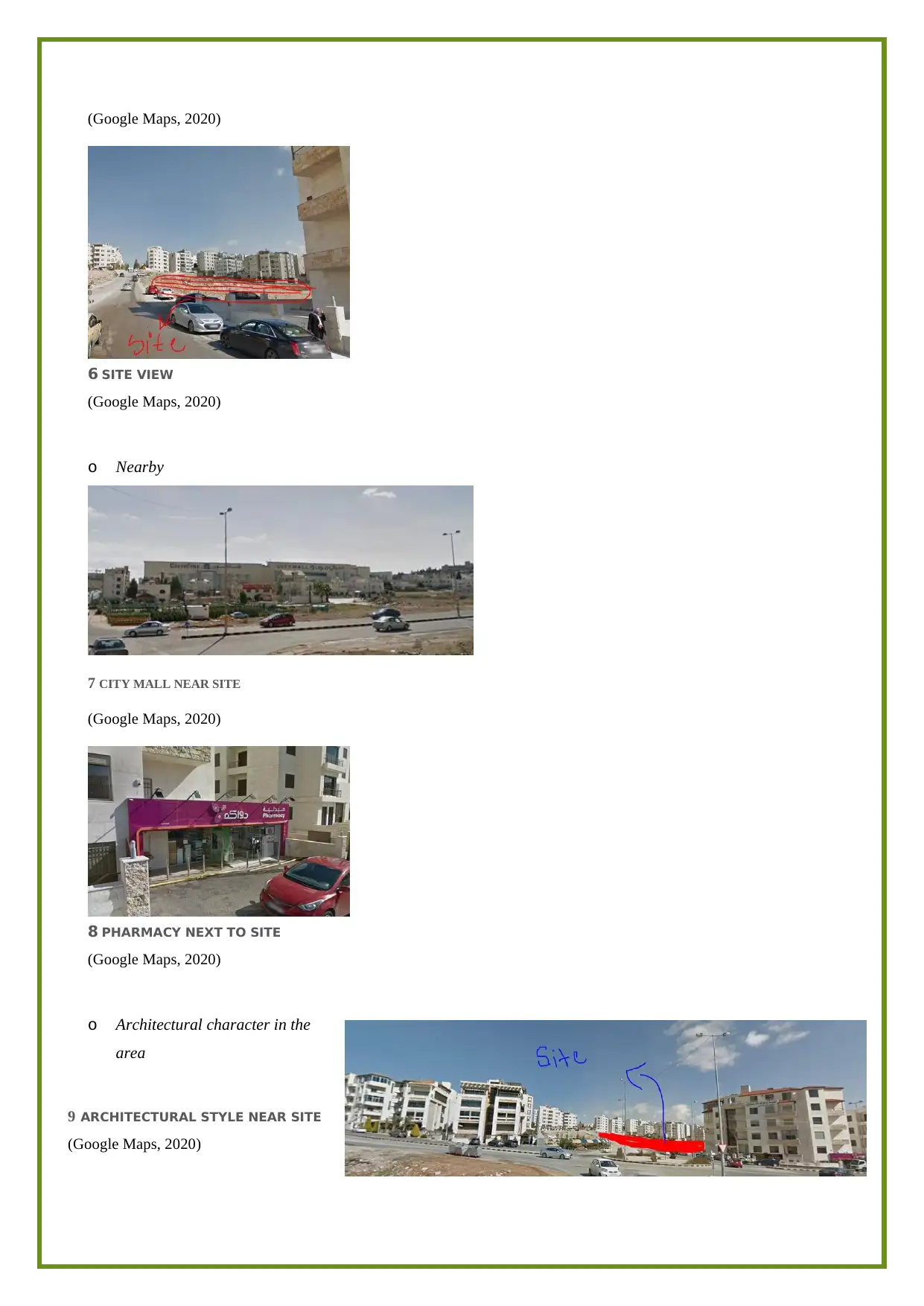
(Google Maps, 2020)
o Nearby
7 CITY MALL NEAR SITE
(Google Maps, 2020)
o Architectural character in the
area
6 SITE VIEW
(Google Maps, 2020)
8 PHARMACY NEXT TO SITE
(Google Maps, 2020)
9 ARCHITECTURAL STYLE NEAR SITE
(Google Maps, 2020)
o Nearby
7 CITY MALL NEAR SITE
(Google Maps, 2020)
o Architectural character in the
area
6 SITE VIEW
(Google Maps, 2020)
8 PHARMACY NEXT TO SITE
(Google Maps, 2020)
9 ARCHITECTURAL STYLE NEAR SITE
(Google Maps, 2020)
Paraphrase This Document
Need a fresh take? Get an instant paraphrase of this document with our AI Paraphraser
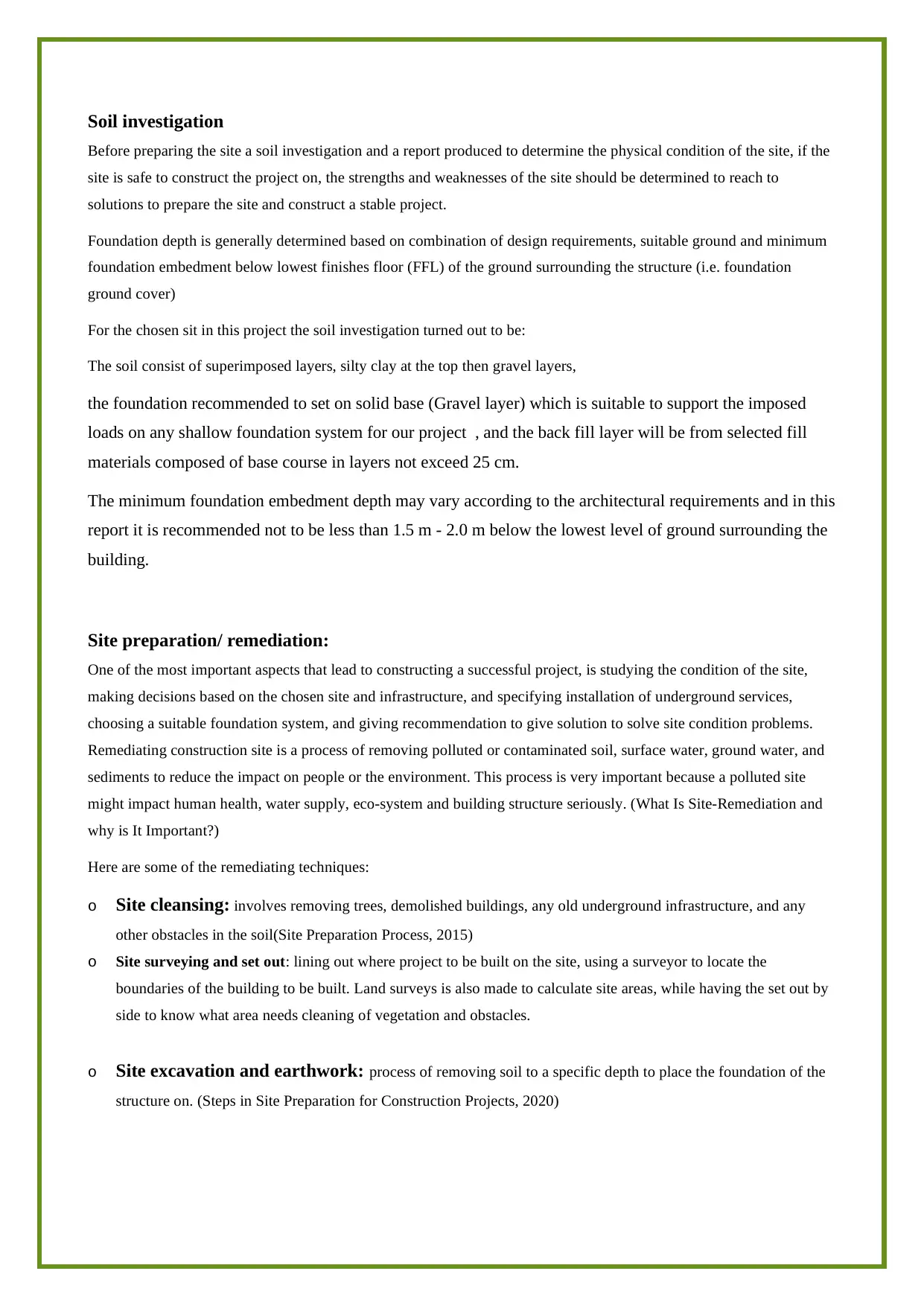
Soil investigation
Before preparing the site a soil investigation and a report produced to determine the physical condition of the site, if the
site is safe to construct the project on, the strengths and weaknesses of the site should be determined to reach to
solutions to prepare the site and construct a stable project.
Foundation depth is generally determined based on combination of design requirements, suitable ground and minimum
foundation embedment below lowest finishes floor (FFL) of the ground surrounding the structure (i.e. foundation
ground cover)
For the chosen sit in this project the soil investigation turned out to be:
The soil consist of superimposed layers, silty clay at the top then gravel layers,
the foundation recommended to set on solid base (Gravel layer) which is suitable to support the imposed
loads on any shallow foundation system for our project , and the back fill layer will be from selected fill
materials composed of base course in layers not exceed 25 cm.
The minimum foundation embedment depth may vary according to the architectural requirements and in this
report it is recommended not to be less than 1.5 m - 2.0 m below the lowest level of ground surrounding the
building.
Site preparation/ remediation:
One of the most important aspects that lead to constructing a successful project, is studying the condition of the site,
making decisions based on the chosen site and infrastructure, and specifying installation of underground services,
choosing a suitable foundation system, and giving recommendation to give solution to solve site condition problems.
Remediating construction site is a process of removing polluted or contaminated soil, surface water, ground water, and
sediments to reduce the impact on people or the environment. This process is very important because a polluted site
might impact human health, water supply, eco-system and building structure seriously. (What Is Site-Remediation and
why is It Important?)
Here are some of the remediating techniques:
o Site cleansing: involves removing trees, demolished buildings, any old underground infrastructure, and any
other obstacles in the soil(Site Preparation Process, 2015)
o Site surveying and set out: lining out where project to be built on the site, using a surveyor to locate the
boundaries of the building to be built. Land surveys is also made to calculate site areas, while having the set out by
side to know what area needs cleaning of vegetation and obstacles.
o Site excavation and earthwork: process of removing soil to a specific depth to place the foundation of the
structure on. (Steps in Site Preparation for Construction Projects, 2020)
Before preparing the site a soil investigation and a report produced to determine the physical condition of the site, if the
site is safe to construct the project on, the strengths and weaknesses of the site should be determined to reach to
solutions to prepare the site and construct a stable project.
Foundation depth is generally determined based on combination of design requirements, suitable ground and minimum
foundation embedment below lowest finishes floor (FFL) of the ground surrounding the structure (i.e. foundation
ground cover)
For the chosen sit in this project the soil investigation turned out to be:
The soil consist of superimposed layers, silty clay at the top then gravel layers,
the foundation recommended to set on solid base (Gravel layer) which is suitable to support the imposed
loads on any shallow foundation system for our project , and the back fill layer will be from selected fill
materials composed of base course in layers not exceed 25 cm.
The minimum foundation embedment depth may vary according to the architectural requirements and in this
report it is recommended not to be less than 1.5 m - 2.0 m below the lowest level of ground surrounding the
building.
Site preparation/ remediation:
One of the most important aspects that lead to constructing a successful project, is studying the condition of the site,
making decisions based on the chosen site and infrastructure, and specifying installation of underground services,
choosing a suitable foundation system, and giving recommendation to give solution to solve site condition problems.
Remediating construction site is a process of removing polluted or contaminated soil, surface water, ground water, and
sediments to reduce the impact on people or the environment. This process is very important because a polluted site
might impact human health, water supply, eco-system and building structure seriously. (What Is Site-Remediation and
why is It Important?)
Here are some of the remediating techniques:
o Site cleansing: involves removing trees, demolished buildings, any old underground infrastructure, and any
other obstacles in the soil(Site Preparation Process, 2015)
o Site surveying and set out: lining out where project to be built on the site, using a surveyor to locate the
boundaries of the building to be built. Land surveys is also made to calculate site areas, while having the set out by
side to know what area needs cleaning of vegetation and obstacles.
o Site excavation and earthwork: process of removing soil to a specific depth to place the foundation of the
structure on. (Steps in Site Preparation for Construction Projects, 2020)
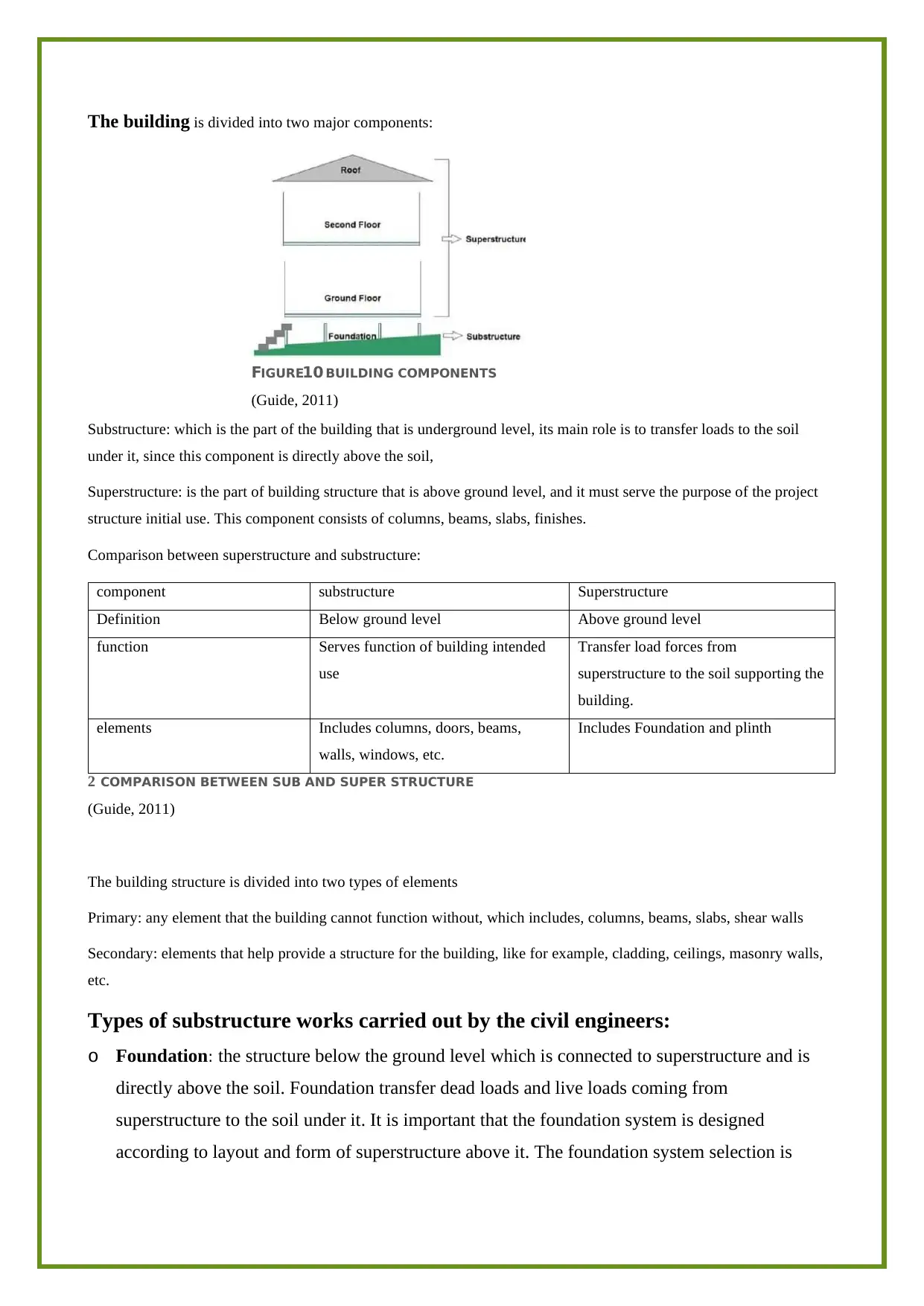
The building is divided into two major components:
Substructure: which is the part of the building that is underground level, its main role is to transfer loads to the soil
under it, since this component is directly above the soil,
Superstructure: is the part of building structure that is above ground level, and it must serve the purpose of the project
structure initial use. This component consists of columns, beams, slabs, finishes.
Comparison between superstructure and substructure:
component substructure Superstructure
Definition Below ground level Above ground level
function Serves function of building intended
use
Transfer load forces from
superstructure to the soil supporting the
building.
elements Includes columns, doors, beams,
walls, windows, etc.
Includes Foundation and plinth
2 COMPARISON BETWEEN SUB AND SUPER STRUCTURE
(Guide, 2011)
The building structure is divided into two types of elements
Primary: any element that the building cannot function without, which includes, columns, beams, slabs, shear walls
Secondary: elements that help provide a structure for the building, like for example, cladding, ceilings, masonry walls,
etc.
Types of substructure works carried out by the civil engineers:
o Foundation: the structure below the ground level which is connected to superstructure and is
directly above the soil. Foundation transfer dead loads and live loads coming from
superstructure to the soil under it. It is important that the foundation system is designed
according to layout and form of superstructure above it. The foundation system selection is
FIGURE10 BUILDING COMPONENTS
(Guide, 2011)
Substructure: which is the part of the building that is underground level, its main role is to transfer loads to the soil
under it, since this component is directly above the soil,
Superstructure: is the part of building structure that is above ground level, and it must serve the purpose of the project
structure initial use. This component consists of columns, beams, slabs, finishes.
Comparison between superstructure and substructure:
component substructure Superstructure
Definition Below ground level Above ground level
function Serves function of building intended
use
Transfer load forces from
superstructure to the soil supporting the
building.
elements Includes columns, doors, beams,
walls, windows, etc.
Includes Foundation and plinth
2 COMPARISON BETWEEN SUB AND SUPER STRUCTURE
(Guide, 2011)
The building structure is divided into two types of elements
Primary: any element that the building cannot function without, which includes, columns, beams, slabs, shear walls
Secondary: elements that help provide a structure for the building, like for example, cladding, ceilings, masonry walls,
etc.
Types of substructure works carried out by the civil engineers:
o Foundation: the structure below the ground level which is connected to superstructure and is
directly above the soil. Foundation transfer dead loads and live loads coming from
superstructure to the soil under it. It is important that the foundation system is designed
according to layout and form of superstructure above it. The foundation system selection is
FIGURE10 BUILDING COMPONENTS
(Guide, 2011)
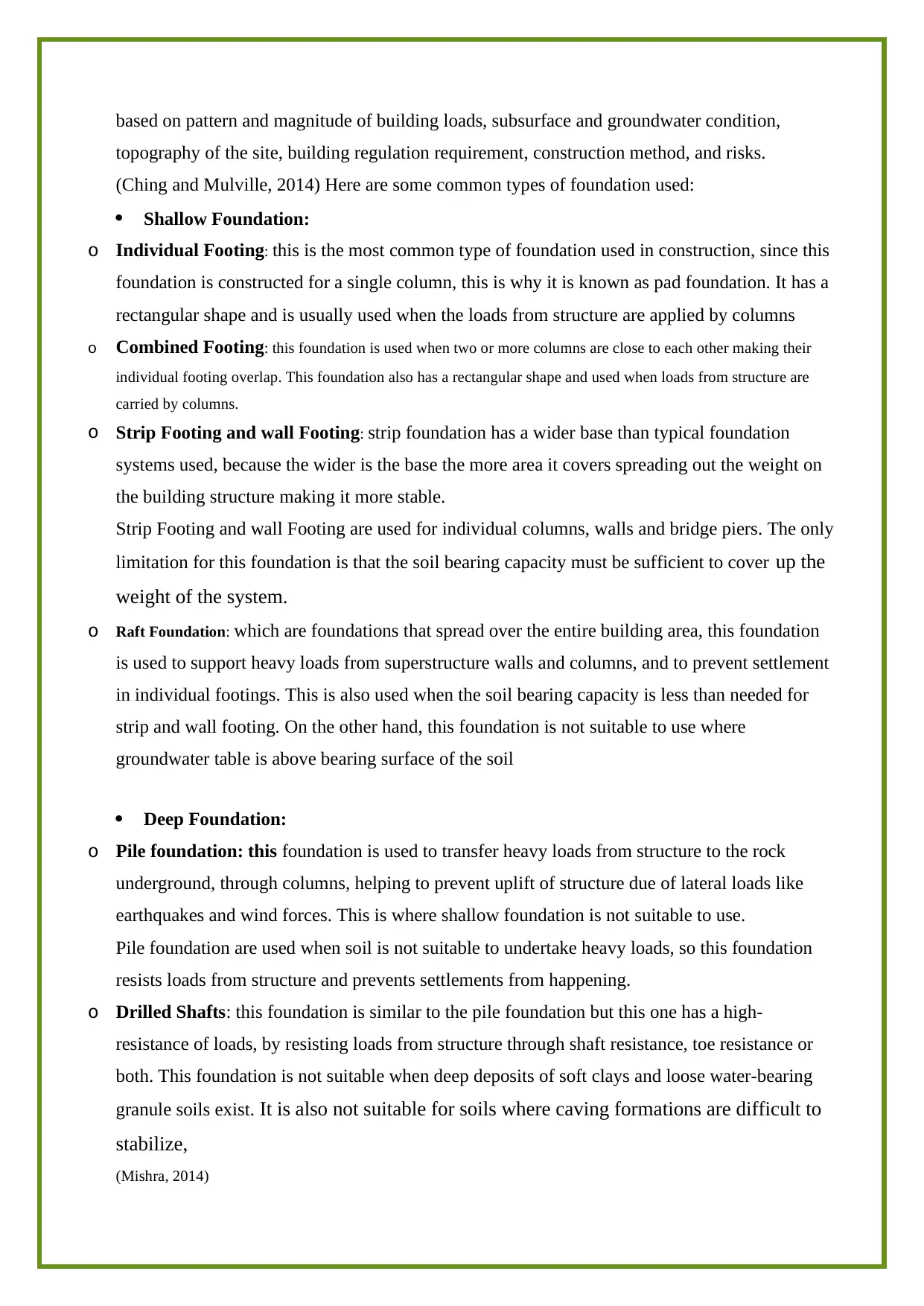
based on pattern and magnitude of building loads, subsurface and groundwater condition,
topography of the site, building regulation requirement, construction method, and risks.
(Ching and Mulville, 2014) Here are some common types of foundation used:
Shallow Foundation:
o Individual Footing: this is the most common type of foundation used in construction, since this
foundation is constructed for a single column, this is why it is known as pad foundation. It has a
rectangular shape and is usually used when the loads from structure are applied by columns
o Combined Footing: this foundation is used when two or more columns are close to each other making their
individual footing overlap. This foundation also has a rectangular shape and used when loads from structure are
carried by columns.
o Strip Footing and wall Footing: strip foundation has a wider base than typical foundation
systems used, because the wider is the base the more area it covers spreading out the weight on
the building structure making it more stable.
Strip Footing and wall Footing are used for individual columns, walls and bridge piers. The only
limitation for this foundation is that the soil bearing capacity must be sufficient to cover up the
weight of the system.
o Raft Foundation: which are foundations that spread over the entire building area, this foundation
is used to support heavy loads from superstructure walls and columns, and to prevent settlement
in individual footings. This is also used when the soil bearing capacity is less than needed for
strip and wall footing. On the other hand, this foundation is not suitable to use where
groundwater table is above bearing surface of the soil
Deep Foundation:
o Pile foundation: this foundation is used to transfer heavy loads from structure to the rock
underground, through columns, helping to prevent uplift of structure due of lateral loads like
earthquakes and wind forces. This is where shallow foundation is not suitable to use.
Pile foundation are used when soil is not suitable to undertake heavy loads, so this foundation
resists loads from structure and prevents settlements from happening.
o Drilled Shafts: this foundation is similar to the pile foundation but this one has a high-
resistance of loads, by resisting loads from structure through shaft resistance, toe resistance or
both. This foundation is not suitable when deep deposits of soft clays and loose water-bearing
granule soils exist. It is also not suitable for soils where caving formations are difficult to
stabilize,
(Mishra, 2014)
topography of the site, building regulation requirement, construction method, and risks.
(Ching and Mulville, 2014) Here are some common types of foundation used:
Shallow Foundation:
o Individual Footing: this is the most common type of foundation used in construction, since this
foundation is constructed for a single column, this is why it is known as pad foundation. It has a
rectangular shape and is usually used when the loads from structure are applied by columns
o Combined Footing: this foundation is used when two or more columns are close to each other making their
individual footing overlap. This foundation also has a rectangular shape and used when loads from structure are
carried by columns.
o Strip Footing and wall Footing: strip foundation has a wider base than typical foundation
systems used, because the wider is the base the more area it covers spreading out the weight on
the building structure making it more stable.
Strip Footing and wall Footing are used for individual columns, walls and bridge piers. The only
limitation for this foundation is that the soil bearing capacity must be sufficient to cover up the
weight of the system.
o Raft Foundation: which are foundations that spread over the entire building area, this foundation
is used to support heavy loads from superstructure walls and columns, and to prevent settlement
in individual footings. This is also used when the soil bearing capacity is less than needed for
strip and wall footing. On the other hand, this foundation is not suitable to use where
groundwater table is above bearing surface of the soil
Deep Foundation:
o Pile foundation: this foundation is used to transfer heavy loads from structure to the rock
underground, through columns, helping to prevent uplift of structure due of lateral loads like
earthquakes and wind forces. This is where shallow foundation is not suitable to use.
Pile foundation are used when soil is not suitable to undertake heavy loads, so this foundation
resists loads from structure and prevents settlements from happening.
o Drilled Shafts: this foundation is similar to the pile foundation but this one has a high-
resistance of loads, by resisting loads from structure through shaft resistance, toe resistance or
both. This foundation is not suitable when deep deposits of soft clays and loose water-bearing
granule soils exist. It is also not suitable for soils where caving formations are difficult to
stabilize,
(Mishra, 2014)
Secure Best Marks with AI Grader
Need help grading? Try our AI Grader for instant feedback on your assignments.
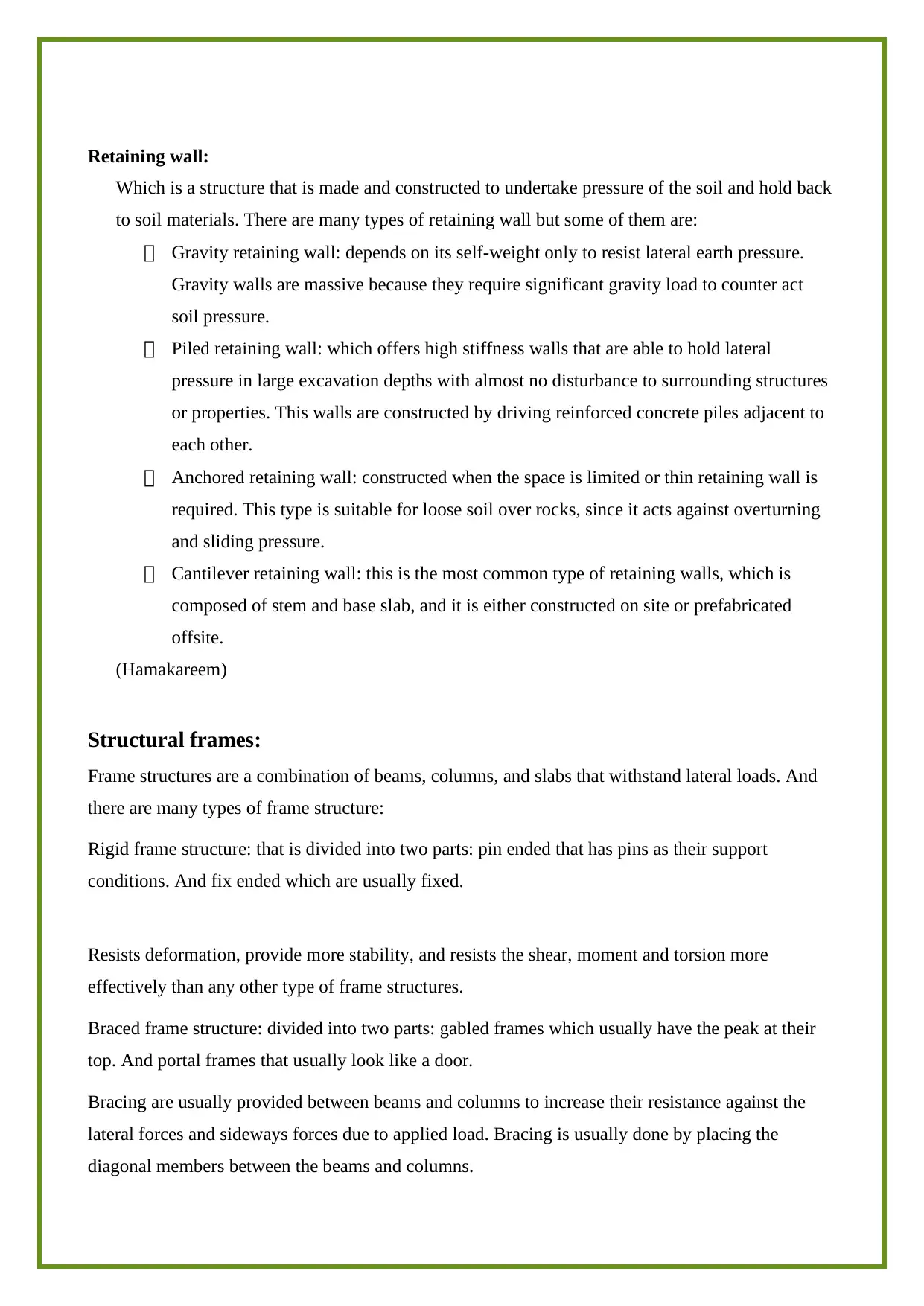
Retaining wall:
Which is a structure that is made and constructed to undertake pressure of the soil and hold back
to soil materials. There are many types of retaining wall but some of them are:
Gravity retaining wall: depends on its self-weight only to resist lateral earth pressure.
Gravity walls are massive because they require significant gravity load to counter act
soil pressure.
Piled retaining wall: which offers high stiffness walls that are able to hold lateral
pressure in large excavation depths with almost no disturbance to surrounding structures
or properties. This walls are constructed by driving reinforced concrete piles adjacent to
each other.
Anchored retaining wall: constructed when the space is limited or thin retaining wall is
required. This type is suitable for loose soil over rocks, since it acts against overturning
and sliding pressure.
Cantilever retaining wall: this is the most common type of retaining walls, which is
composed of stem and base slab, and it is either constructed on site or prefabricated
offsite.
(Hamakareem)
Structural frames:
Frame structures are a combination of beams, columns, and slabs that withstand lateral loads. And
there are many types of frame structure:
Rigid frame structure: that is divided into two parts: pin ended that has pins as their support
conditions. And fix ended which are usually fixed.
Resists deformation, provide more stability, and resists the shear, moment and torsion more
effectively than any other type of frame structures.
Braced frame structure: divided into two parts: gabled frames which usually have the peak at their
top. And portal frames that usually look like a door.
Bracing are usually provided between beams and columns to increase their resistance against the
lateral forces and sideways forces due to applied load. Bracing is usually done by placing the
diagonal members between the beams and columns.
Which is a structure that is made and constructed to undertake pressure of the soil and hold back
to soil materials. There are many types of retaining wall but some of them are:
Gravity retaining wall: depends on its self-weight only to resist lateral earth pressure.
Gravity walls are massive because they require significant gravity load to counter act
soil pressure.
Piled retaining wall: which offers high stiffness walls that are able to hold lateral
pressure in large excavation depths with almost no disturbance to surrounding structures
or properties. This walls are constructed by driving reinforced concrete piles adjacent to
each other.
Anchored retaining wall: constructed when the space is limited or thin retaining wall is
required. This type is suitable for loose soil over rocks, since it acts against overturning
and sliding pressure.
Cantilever retaining wall: this is the most common type of retaining walls, which is
composed of stem and base slab, and it is either constructed on site or prefabricated
offsite.
(Hamakareem)
Structural frames:
Frame structures are a combination of beams, columns, and slabs that withstand lateral loads. And
there are many types of frame structure:
Rigid frame structure: that is divided into two parts: pin ended that has pins as their support
conditions. And fix ended which are usually fixed.
Resists deformation, provide more stability, and resists the shear, moment and torsion more
effectively than any other type of frame structures.
Braced frame structure: divided into two parts: gabled frames which usually have the peak at their
top. And portal frames that usually look like a door.
Bracing are usually provided between beams and columns to increase their resistance against the
lateral forces and sideways forces due to applied load. Bracing is usually done by placing the
diagonal members between the beams and columns.
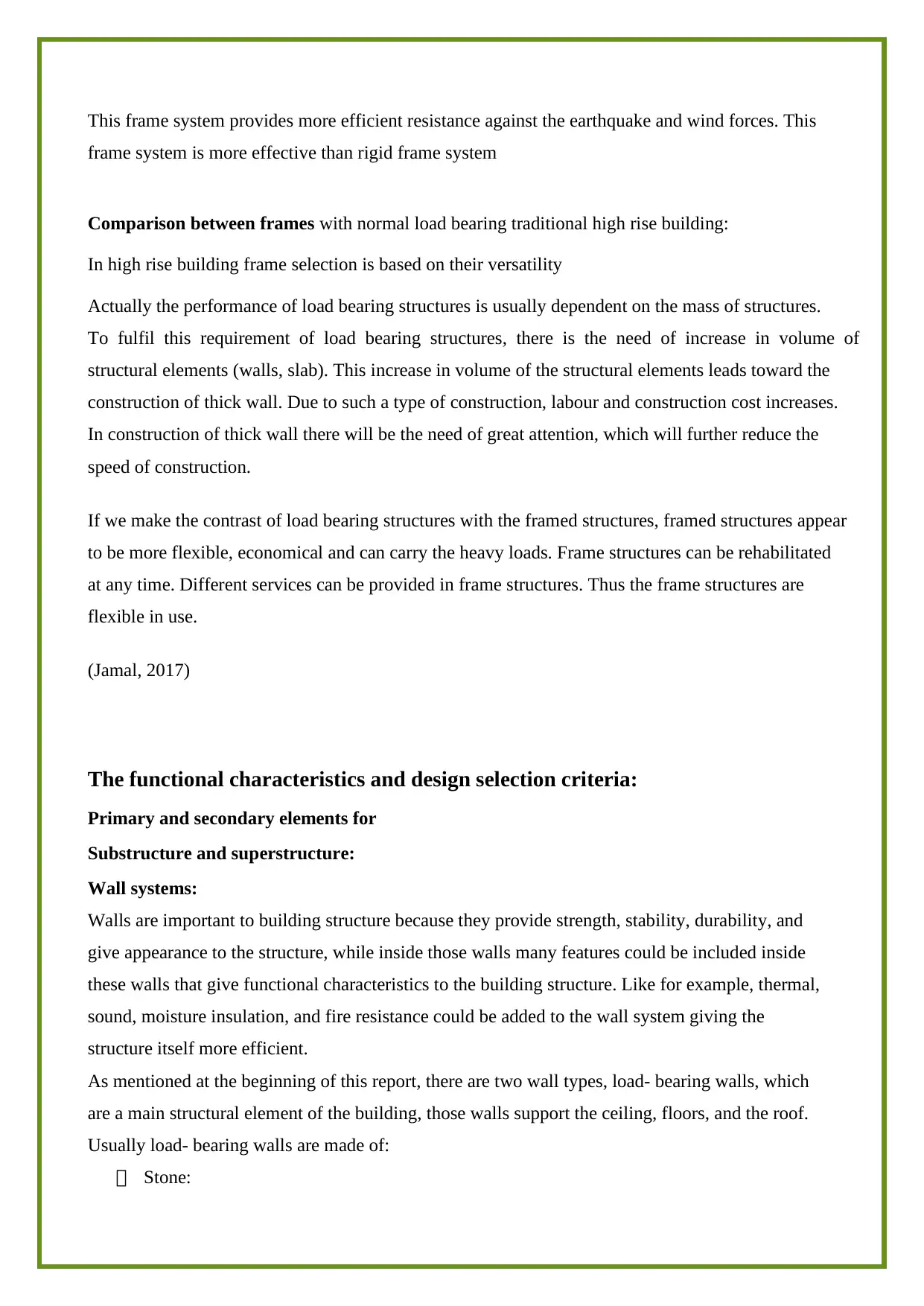
This frame system provides more efficient resistance against the earthquake and wind forces. This
frame system is more effective than rigid frame system
Comparison between frames with normal load bearing traditional high rise building:
In high rise building frame selection is based on their versatility
Actually the performance of load bearing structures is usually dependent on the mass of structures.
To fulfil this requirement of load bearing structures, there is the need of increase in volume of
structural elements (walls, slab). This increase in volume of the structural elements leads toward the
construction of thick wall. Due to such a type of construction, labour and construction cost increases.
In construction of thick wall there will be the need of great attention, which will further reduce the
speed of construction.
If we make the contrast of load bearing structures with the framed structures, framed structures appear
to be more flexible, economical and can carry the heavy loads. Frame structures can be rehabilitated
at any time. Different services can be provided in frame structures. Thus the frame structures are
flexible in use.
(Jamal, 2017)
The functional characteristics and design selection criteria:
Primary and secondary elements for
Substructure and superstructure:
Wall systems:
Walls are important to building structure because they provide strength, stability, durability, and
give appearance to the structure, while inside those walls many features could be included inside
these walls that give functional characteristics to the building structure. Like for example, thermal,
sound, moisture insulation, and fire resistance could be added to the wall system giving the
structure itself more efficient.
As mentioned at the beginning of this report, there are two wall types, load- bearing walls, which
are a main structural element of the building, those walls support the ceiling, floors, and the roof.
Usually load- bearing walls are made of:
Stone:
frame system is more effective than rigid frame system
Comparison between frames with normal load bearing traditional high rise building:
In high rise building frame selection is based on their versatility
Actually the performance of load bearing structures is usually dependent on the mass of structures.
To fulfil this requirement of load bearing structures, there is the need of increase in volume of
structural elements (walls, slab). This increase in volume of the structural elements leads toward the
construction of thick wall. Due to such a type of construction, labour and construction cost increases.
In construction of thick wall there will be the need of great attention, which will further reduce the
speed of construction.
If we make the contrast of load bearing structures with the framed structures, framed structures appear
to be more flexible, economical and can carry the heavy loads. Frame structures can be rehabilitated
at any time. Different services can be provided in frame structures. Thus the frame structures are
flexible in use.
(Jamal, 2017)
The functional characteristics and design selection criteria:
Primary and secondary elements for
Substructure and superstructure:
Wall systems:
Walls are important to building structure because they provide strength, stability, durability, and
give appearance to the structure, while inside those walls many features could be included inside
these walls that give functional characteristics to the building structure. Like for example, thermal,
sound, moisture insulation, and fire resistance could be added to the wall system giving the
structure itself more efficient.
As mentioned at the beginning of this report, there are two wall types, load- bearing walls, which
are a main structural element of the building, those walls support the ceiling, floors, and the roof.
Usually load- bearing walls are made of:
Stone:
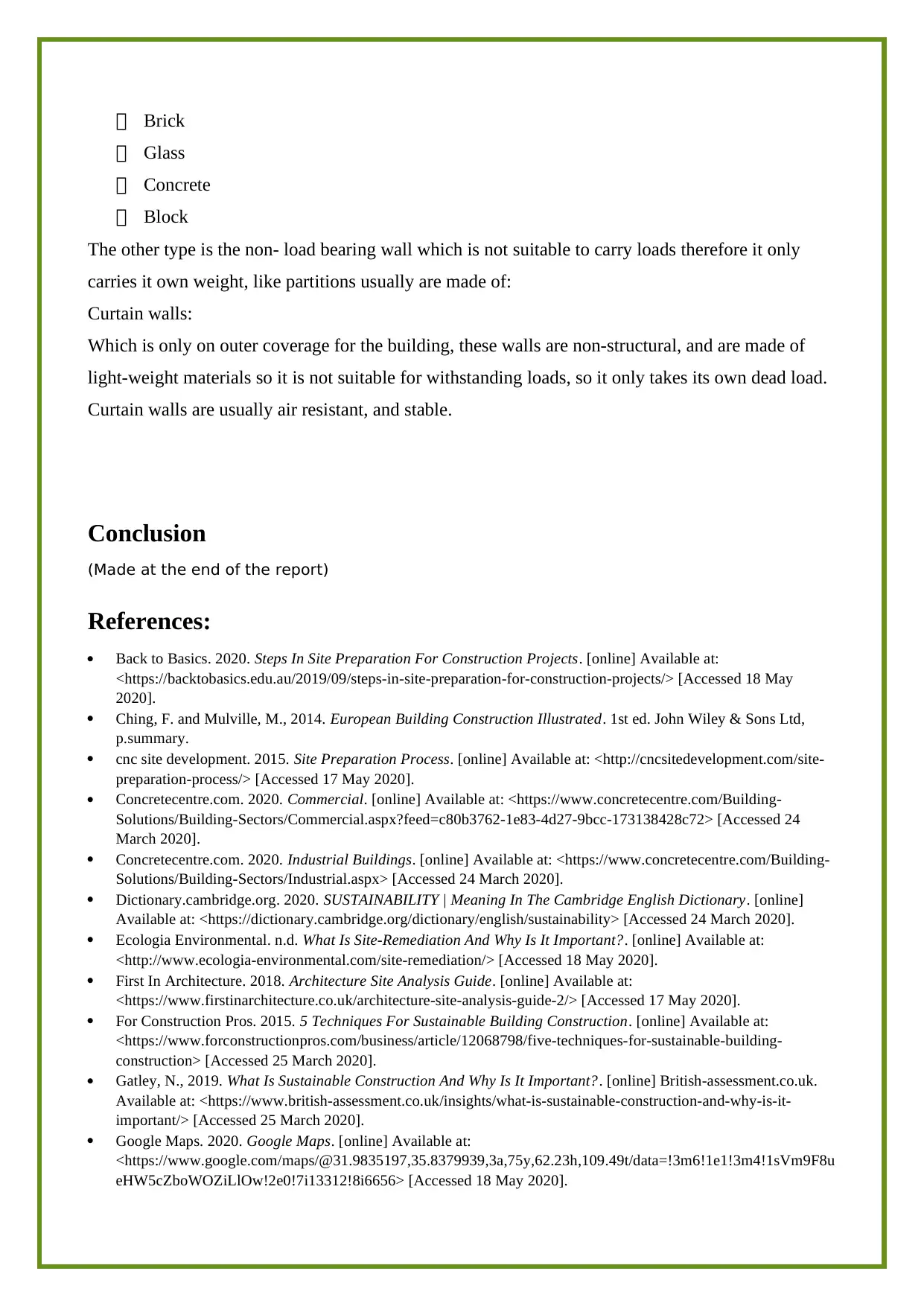
Brick
Glass
Concrete
Block
The other type is the non- load bearing wall which is not suitable to carry loads therefore it only
carries it own weight, like partitions usually are made of:
Curtain walls:
Which is only on outer coverage for the building, these walls are non-structural, and are made of
light-weight materials so it is not suitable for withstanding loads, so it only takes its own dead load.
Curtain walls are usually air resistant, and stable.
Conclusion
(Made at the end of the report)
References:
Back to Basics. 2020. Steps In Site Preparation For Construction Projects. [online] Available at:
<https://backtobasics.edu.au/2019/09/steps-in-site-preparation-for-construction-projects/> [Accessed 18 May
2020].
Ching, F. and Mulville, M., 2014. European Building Construction Illustrated. 1st ed. John Wiley & Sons Ltd,
p.summary.
cnc site development. 2015. Site Preparation Process. [online] Available at: <http://cncsitedevelopment.com/site-
preparation-process/> [Accessed 17 May 2020].
Concretecentre.com. 2020. Commercial. [online] Available at: <https://www.concretecentre.com/Building-
Solutions/Building-Sectors/Commercial.aspx?feed=c80b3762-1e83-4d27-9bcc-173138428c72> [Accessed 24
March 2020].
Concretecentre.com. 2020. Industrial Buildings. [online] Available at: <https://www.concretecentre.com/Building-
Solutions/Building-Sectors/Industrial.aspx> [Accessed 24 March 2020].
Dictionary.cambridge.org. 2020. SUSTAINABILITY | Meaning In The Cambridge English Dictionary. [online]
Available at: <https://dictionary.cambridge.org/dictionary/english/sustainability> [Accessed 24 March 2020].
Ecologia Environmental. n.d. What Is Site-Remediation And Why Is It Important?. [online] Available at:
<http://www.ecologia-environmental.com/site-remediation/> [Accessed 18 May 2020].
First In Architecture. 2018. Architecture Site Analysis Guide. [online] Available at:
<https://www.firstinarchitecture.co.uk/architecture-site-analysis-guide-2/> [Accessed 17 May 2020].
For Construction Pros. 2015. 5 Techniques For Sustainable Building Construction. [online] Available at:
<https://www.forconstructionpros.com/business/article/12068798/five-techniques-for-sustainable-building-
construction> [Accessed 25 March 2020].
Gatley, N., 2019. What Is Sustainable Construction And Why Is It Important?. [online] British-assessment.co.uk.
Available at: <https://www.british-assessment.co.uk/insights/what-is-sustainable-construction-and-why-is-it-
important/> [Accessed 25 March 2020].
Google Maps. 2020. Google Maps. [online] Available at:
<https://www.google.com/maps/@31.9835197,35.8379939,3a,75y,62.23h,109.49t/data=!3m6!1e1!3m4!1sVm9F8u
eHW5cZboWOZiLlOw!2e0!7i13312!8i6656> [Accessed 18 May 2020].
Glass
Concrete
Block
The other type is the non- load bearing wall which is not suitable to carry loads therefore it only
carries it own weight, like partitions usually are made of:
Curtain walls:
Which is only on outer coverage for the building, these walls are non-structural, and are made of
light-weight materials so it is not suitable for withstanding loads, so it only takes its own dead load.
Curtain walls are usually air resistant, and stable.
Conclusion
(Made at the end of the report)
References:
Back to Basics. 2020. Steps In Site Preparation For Construction Projects. [online] Available at:
<https://backtobasics.edu.au/2019/09/steps-in-site-preparation-for-construction-projects/> [Accessed 18 May
2020].
Ching, F. and Mulville, M., 2014. European Building Construction Illustrated. 1st ed. John Wiley & Sons Ltd,
p.summary.
cnc site development. 2015. Site Preparation Process. [online] Available at: <http://cncsitedevelopment.com/site-
preparation-process/> [Accessed 17 May 2020].
Concretecentre.com. 2020. Commercial. [online] Available at: <https://www.concretecentre.com/Building-
Solutions/Building-Sectors/Commercial.aspx?feed=c80b3762-1e83-4d27-9bcc-173138428c72> [Accessed 24
March 2020].
Concretecentre.com. 2020. Industrial Buildings. [online] Available at: <https://www.concretecentre.com/Building-
Solutions/Building-Sectors/Industrial.aspx> [Accessed 24 March 2020].
Dictionary.cambridge.org. 2020. SUSTAINABILITY | Meaning In The Cambridge English Dictionary. [online]
Available at: <https://dictionary.cambridge.org/dictionary/english/sustainability> [Accessed 24 March 2020].
Ecologia Environmental. n.d. What Is Site-Remediation And Why Is It Important?. [online] Available at:
<http://www.ecologia-environmental.com/site-remediation/> [Accessed 18 May 2020].
First In Architecture. 2018. Architecture Site Analysis Guide. [online] Available at:
<https://www.firstinarchitecture.co.uk/architecture-site-analysis-guide-2/> [Accessed 17 May 2020].
For Construction Pros. 2015. 5 Techniques For Sustainable Building Construction. [online] Available at:
<https://www.forconstructionpros.com/business/article/12068798/five-techniques-for-sustainable-building-
construction> [Accessed 25 March 2020].
Gatley, N., 2019. What Is Sustainable Construction And Why Is It Important?. [online] British-assessment.co.uk.
Available at: <https://www.british-assessment.co.uk/insights/what-is-sustainable-construction-and-why-is-it-
important/> [Accessed 25 March 2020].
Google Maps. 2020. Google Maps. [online] Available at:
<https://www.google.com/maps/@31.9835197,35.8379939,3a,75y,62.23h,109.49t/data=!3m6!1e1!3m4!1sVm9F8u
eHW5cZboWOZiLlOw!2e0!7i13312!8i6656> [Accessed 18 May 2020].
Paraphrase This Document
Need a fresh take? Get an instant paraphrase of this document with our AI Paraphraser
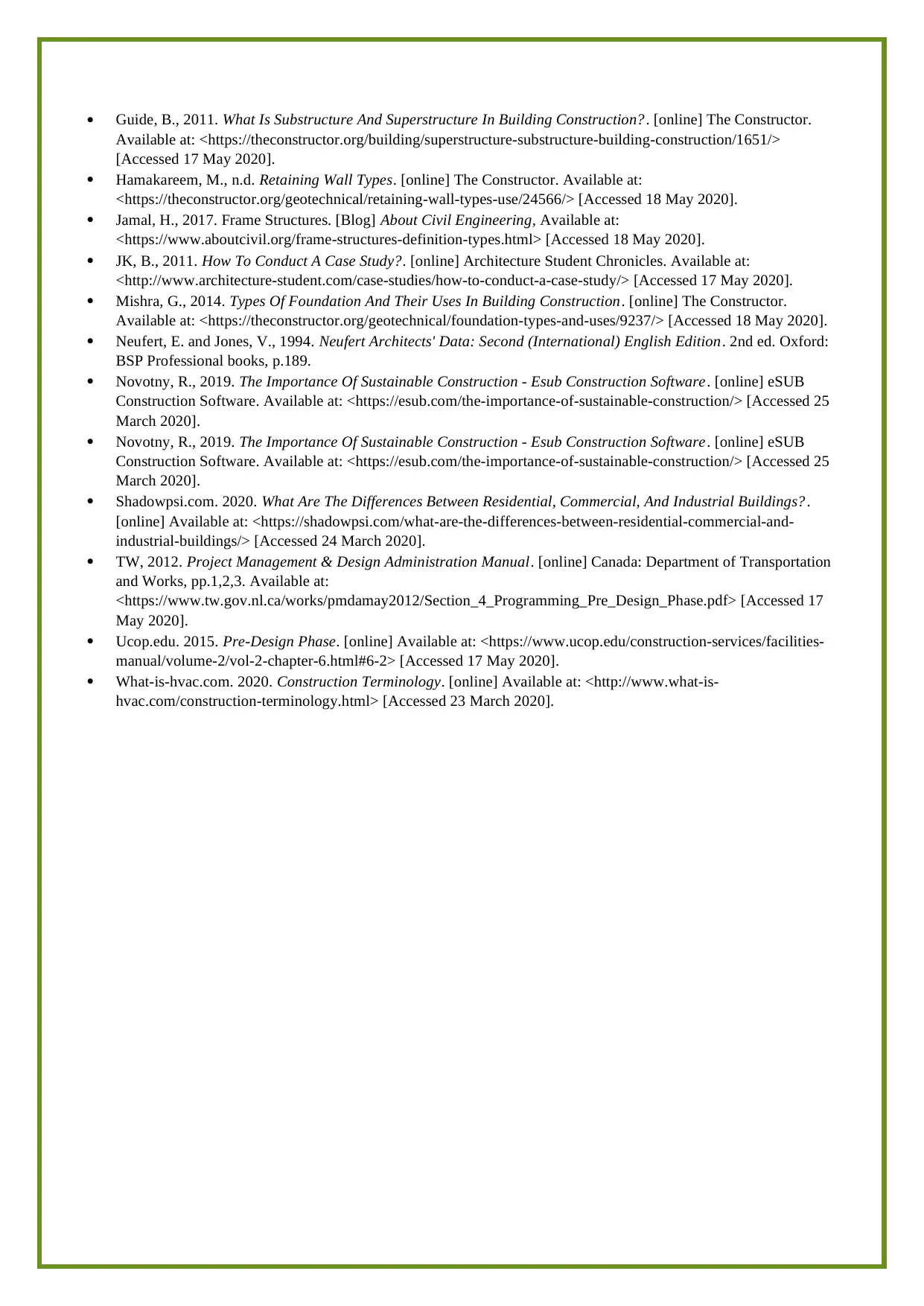
Guide, B., 2011. What Is Substructure And Superstructure In Building Construction?. [online] The Constructor.
Available at: <https://theconstructor.org/building/superstructure-substructure-building-construction/1651/>
[Accessed 17 May 2020].
Hamakareem, M., n.d. Retaining Wall Types. [online] The Constructor. Available at:
<https://theconstructor.org/geotechnical/retaining-wall-types-use/24566/> [Accessed 18 May 2020].
Jamal, H., 2017. Frame Structures. [Blog] About Civil Engineering, Available at:
<https://www.aboutcivil.org/frame-structures-definition-types.html> [Accessed 18 May 2020].
JK, B., 2011. How To Conduct A Case Study?. [online] Architecture Student Chronicles. Available at:
<http://www.architecture-student.com/case-studies/how-to-conduct-a-case-study/> [Accessed 17 May 2020].
Mishra, G., 2014. Types Of Foundation And Their Uses In Building Construction. [online] The Constructor.
Available at: <https://theconstructor.org/geotechnical/foundation-types-and-uses/9237/> [Accessed 18 May 2020].
Neufert, E. and Jones, V., 1994. Neufert Architects' Data: Second (International) English Edition. 2nd ed. Oxford:
BSP Professional books, p.189.
Novotny, R., 2019. The Importance Of Sustainable Construction - Esub Construction Software. [online] eSUB
Construction Software. Available at: <https://esub.com/the-importance-of-sustainable-construction/> [Accessed 25
March 2020].
Novotny, R., 2019. The Importance Of Sustainable Construction - Esub Construction Software. [online] eSUB
Construction Software. Available at: <https://esub.com/the-importance-of-sustainable-construction/> [Accessed 25
March 2020].
Shadowpsi.com. 2020. What Are The Differences Between Residential, Commercial, And Industrial Buildings?.
[online] Available at: <https://shadowpsi.com/what-are-the-differences-between-residential-commercial-and-
industrial-buildings/> [Accessed 24 March 2020].
TW, 2012. Project Management & Design Administration Manual. [online] Canada: Department of Transportation
and Works, pp.1,2,3. Available at:
<https://www.tw.gov.nl.ca/works/pmdamay2012/Section_4_Programming_Pre_Design_Phase.pdf> [Accessed 17
May 2020].
Ucop.edu. 2015. Pre-Design Phase. [online] Available at: <https://www.ucop.edu/construction-services/facilities-
manual/volume-2/vol-2-chapter-6.html#6-2> [Accessed 17 May 2020].
What-is-hvac.com. 2020. Construction Terminology. [online] Available at: <http://www.what-is-
hvac.com/construction-terminology.html> [Accessed 23 March 2020].
Available at: <https://theconstructor.org/building/superstructure-substructure-building-construction/1651/>
[Accessed 17 May 2020].
Hamakareem, M., n.d. Retaining Wall Types. [online] The Constructor. Available at:
<https://theconstructor.org/geotechnical/retaining-wall-types-use/24566/> [Accessed 18 May 2020].
Jamal, H., 2017. Frame Structures. [Blog] About Civil Engineering, Available at:
<https://www.aboutcivil.org/frame-structures-definition-types.html> [Accessed 18 May 2020].
JK, B., 2011. How To Conduct A Case Study?. [online] Architecture Student Chronicles. Available at:
<http://www.architecture-student.com/case-studies/how-to-conduct-a-case-study/> [Accessed 17 May 2020].
Mishra, G., 2014. Types Of Foundation And Their Uses In Building Construction. [online] The Constructor.
Available at: <https://theconstructor.org/geotechnical/foundation-types-and-uses/9237/> [Accessed 18 May 2020].
Neufert, E. and Jones, V., 1994. Neufert Architects' Data: Second (International) English Edition. 2nd ed. Oxford:
BSP Professional books, p.189.
Novotny, R., 2019. The Importance Of Sustainable Construction - Esub Construction Software. [online] eSUB
Construction Software. Available at: <https://esub.com/the-importance-of-sustainable-construction/> [Accessed 25
March 2020].
Novotny, R., 2019. The Importance Of Sustainable Construction - Esub Construction Software. [online] eSUB
Construction Software. Available at: <https://esub.com/the-importance-of-sustainable-construction/> [Accessed 25
March 2020].
Shadowpsi.com. 2020. What Are The Differences Between Residential, Commercial, And Industrial Buildings?.
[online] Available at: <https://shadowpsi.com/what-are-the-differences-between-residential-commercial-and-
industrial-buildings/> [Accessed 24 March 2020].
TW, 2012. Project Management & Design Administration Manual. [online] Canada: Department of Transportation
and Works, pp.1,2,3. Available at:
<https://www.tw.gov.nl.ca/works/pmdamay2012/Section_4_Programming_Pre_Design_Phase.pdf> [Accessed 17
May 2020].
Ucop.edu. 2015. Pre-Design Phase. [online] Available at: <https://www.ucop.edu/construction-services/facilities-
manual/volume-2/vol-2-chapter-6.html#6-2> [Accessed 17 May 2020].
What-is-hvac.com. 2020. Construction Terminology. [online] Available at: <http://www.what-is-
hvac.com/construction-terminology.html> [Accessed 23 March 2020].
1 out of 20
Related Documents
Your All-in-One AI-Powered Toolkit for Academic Success.
+13062052269
info@desklib.com
Available 24*7 on WhatsApp / Email
![[object Object]](/_next/static/media/star-bottom.7253800d.svg)
Unlock your academic potential
© 2024 | Zucol Services PVT LTD | All rights reserved.





